São Tomé and Principe Travel Guide
This is a São Tomé and Principe Travel Guide from taste2travel.com
Date Visited: April 2024
Introduction
A quiet, ideal paradise, the Central African island nation of São Tomé and Príncipe has been blessed with a relatively peaceful independence, thus avoiding the stigma of tension and a bloodstained past worn by most countries of mainland Africa.

A young girl, relaxing on Principe Island.
As a destination, this former-Portuguese colony is a relaxed, calm, safe and pleasant travel destination and much more affordable than its Central African neighbours.

A view of the east coast of São Tomé Island.
The country consists of two main islands, the larger São Tomé (854 km2 / 330 sq mi), and the much smaller Príncipe (142 km2/ 55 sq mi), as well as several smaller islets.

A panoramic view of Principe Island from the Terreiro Velho Plantation, home to some of the world’s finest cacao beans.
Both islands are heavily eroded volcanoes which are covered in verdant, undisturbed, rainforest, whose green canopy is pierced by ancient volcanic plugs.

The isolated Praia Grande provides one of the most stunning views of Pico Cão Grande.
The volcanic origin of the islands grants them a magnificent look and makes them perfect for exploration.

Downtown São Tomé features many fine examples of Portuguese colonial-era architecture.
São Tomé, which translates in English as “Saint Thomas”, was named by the Portuguese in honor of Saint Thomas, as they discovered the island on his feast day, while Príncipe Island (Prince’s island) was named in honor of Afonso, Prince of Portugal, the favourite son of the then King of Portugal.
The islands were occupied by the Portuguese from their discovery in 1470 until 1975, when independence was granted by Portugal.
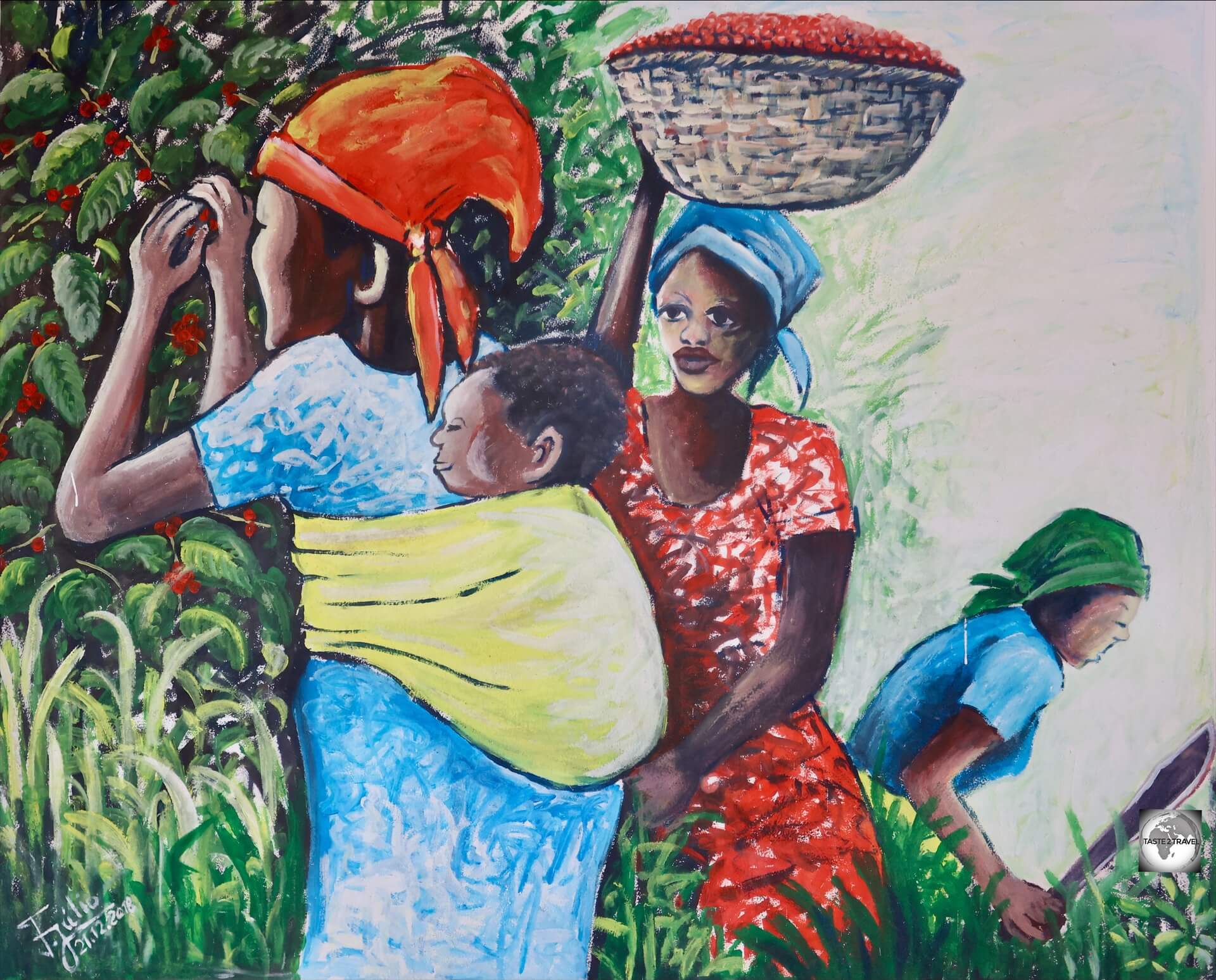
Artwork in the museum at Roça Monte Café shows coffee plantation workers collecting beans.
Once uninhabited, over the centuries, the Portuguese imported a workforce of slave labour, from other Portuguese-speaking African colonies, to work on the many plantations on both São Tomé and Príncipe.
After 505 years of Portuguese occupation, which was marked by a building frenzy that resulted in more than 100 sprawling plantations (“Roças” in Portuguese) being built, São Tomé and Príncipe have been left an abundance of charming, colonial-era relics for tourists to explore.

Laundry, laid out to dry on the 1st floor balcony of the abandoned Roça de Água Izé Hospital.
One of the highlights of a trip to São Tomé and Príncipe is being able to visit the many abandoned roças, many of which were closed down after independence in 1975 and remain frozen in time.
The once-productive roças of São Tomé and Príncipe supplied Europe with most of its cacao and much of its coffee.
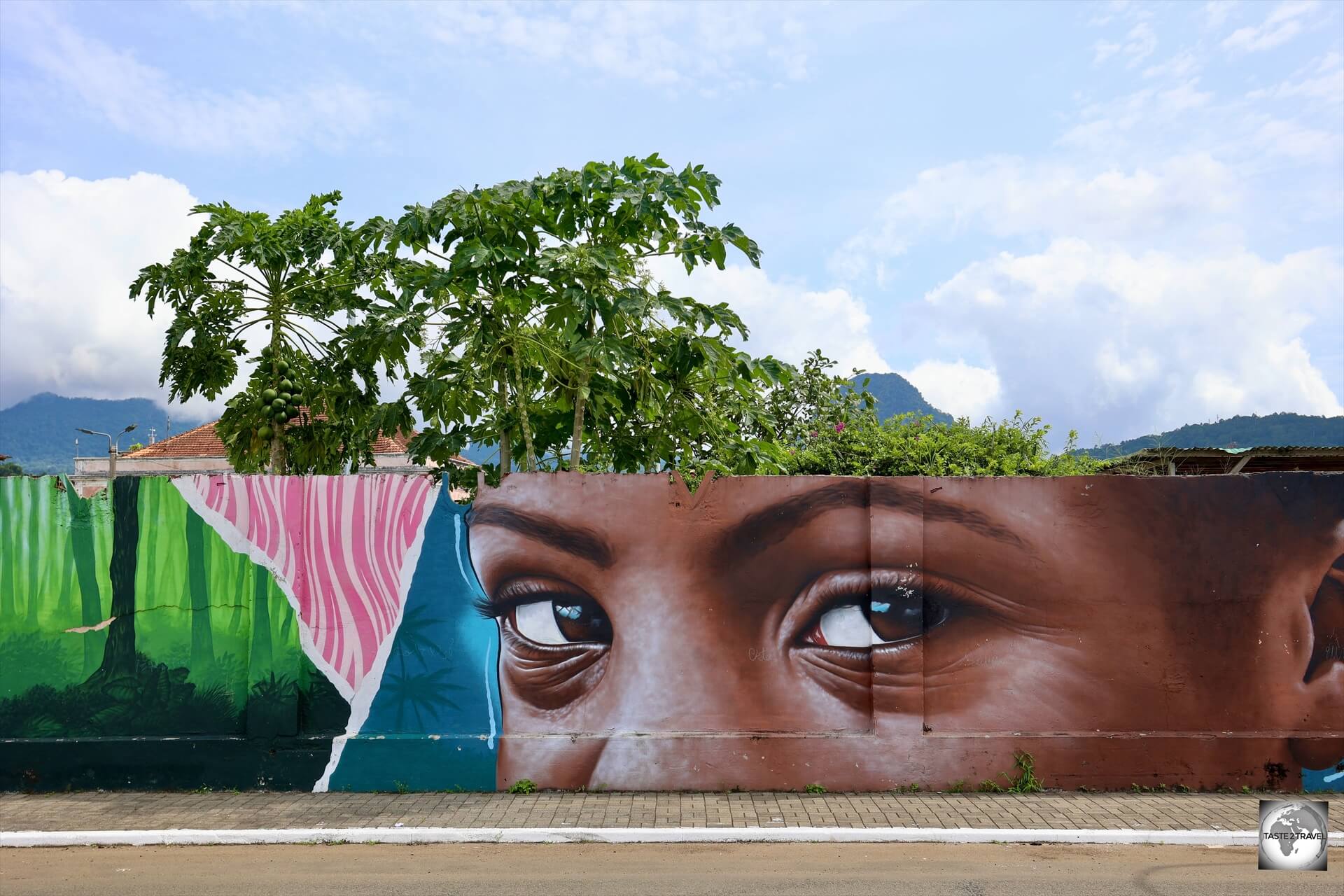
Street art in Santo Antonio, Principe Island.
Unlike in other countries, the treasure trove of architectural gems, which were left by the Portuguese when they hurriedly departed the islands’ shores in the 1970s, remain largely untouched.
São Tomé and Príncipe is a charming and engaging travel destination offering pristine nature, friendly inhabitants and a fascinating history.

A painting, by a local Principe artist.
Highly recommended!
Location
São Tomé and Príncipe is a small island nation located in the Gulf of Guinea, off the western equatorial coast of Central Africa.
The islands lie 300 km (186 mi) due east of Libreville, the capital of Gabon, and 443 km (275 mi) south-west of Malabo, the capital of Equatorial Guinea (click to view my Travel Guide).
Located close to the true centre of the world (GPS coordinates: 0° 20′ 11.5″ North / 6° 43′ 38.4″ East), São Tomé is located slightly north of the equator, while Principe is located 140 kilometres (87 miles) northeast of São Tomé.
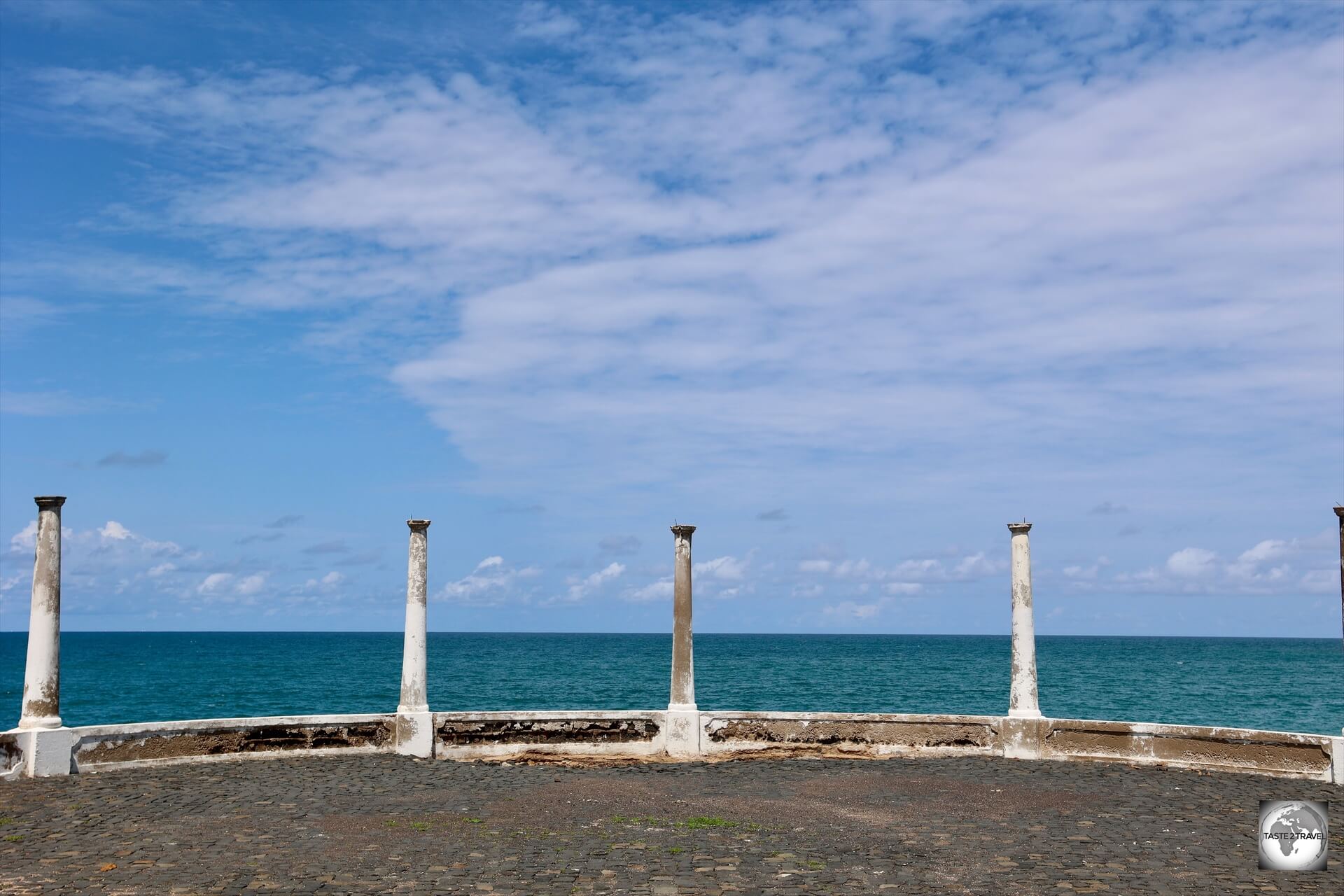
São Tomé (St. Thomas), the capital, and largest city, of São Tomé and Príncipe is located on the Atlantic Ocean.
The islands are surrounded by the Atlantic Ocean. The coastline features sandy beaches, lush rainforests, and volcanic mountain ranges.
Due to its equatorial location, São Tomé and Príncipe has a tropical climate with high humidity.
The islands experience two main seasons: a dry season from June to September and a wet season from October to May.
People

A young boy on São Tomé Island.
Did you know?
São Tomé and Príncipe is the second-smallest and second-least populous African sovereign state after Seychelles.
The islands were uninhabited until their discovery in 1470 by Portuguese explorers João de Santarém and Pedro Escobar.

Relaxing in the main square of Santo Antonio, Principe Island.
Gradually colonised by the Portuguese, and settled throughout the 16th century, they collectively served as a vital commercial and trade centre for the Atlantic slave trade.
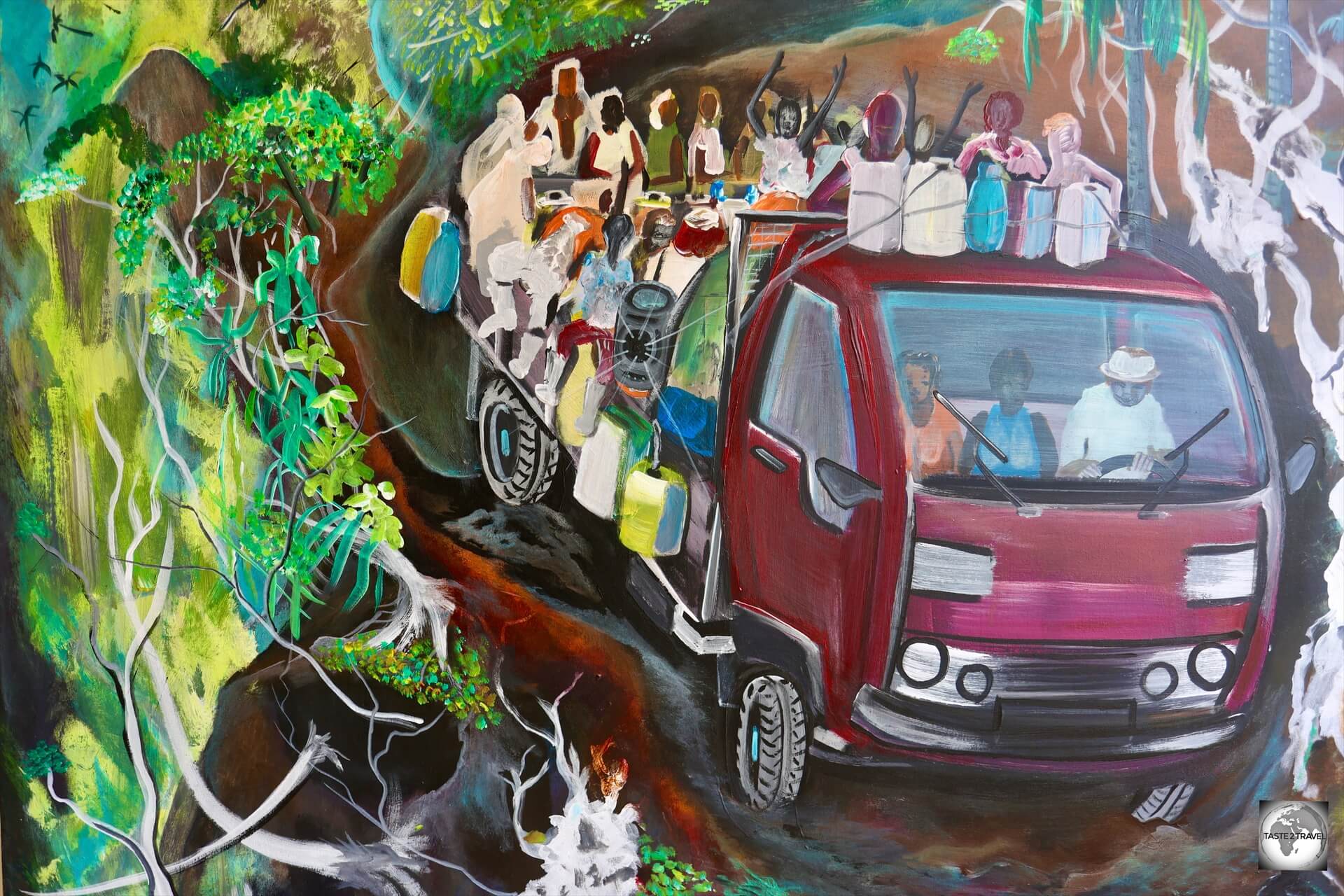
Colourful artwork by a São Tomé artist.
The rich volcanic soil and proximity to the equator made São Tomé and Príncipe ideal for sugar cultivation, followed later by cash crops such as coffee and cocoa; the lucrative plantation economy was heavily dependent upon enslaved Africans.
The population consists mainly of Forros (from forro, Portuguese for “free man”), descendants of immigrant Europeans and enslaved Africans who were imported to work on the many plantations.
The Santomean today are largely descendants of former African slaves, which were bought to the islands from other lusophone (Portuguese- speaking) countries throughout Africa, notably Angola, Mozambique and Cape Verde.

Young girls, relaxing on Principe Island.
The largest city, with a population of 72,000, is the capital – São Tomé – which is located on the northeastern coast of São Tomé Island.

Portuguese colonial-era architecture in downtown São Tomé.
Having been a Portuguese colony from 1470 CE until 1975 CE, the people of São Tomé and Príncipe are a blend of African and Portuguese.

No shortage of smiles from the friendly locals on São Tomé and Príncipe.
Culturally, São Tomé and Príncipe is a blend of African and Portuguese heritage.
You’ll find elements of traditional African music, dance, and art mixed with Portuguese language and Catholic religion.

No shortage of warm smiles from the friendly inhabitants of São Tomé and Príncipe.
The official language of São Tomé and Príncipe is Portuguese, due to its colonial history. However, many people also speak Forro, a Portuguese-based creole language that developed on the islands.
Almost no other languages are spoken, however French is spoken by the small community of Gabonese who have settled in the country for economic reasons.
The majority of the population is Roman Catholic, a legacy of Portuguese colonisation. However, there are also small Protestant and indigenous religious communities.
The people of São Tomé and Príncipe often lead a laid-back, island lifestyle.
Fishing is a significant part of the economy and culture, so you’ll see many locals involved in fishing activities.
Crime rates are very low, making São Tomé and Príncipe one of the safest countries in Africa to visit.
The people of São Tomé and Príncipe are known for their warm hospitality and friendliness toward visitors. It’s not uncommon for locals to strike up conversations with tourists and share their love for their islands.
Overall, the people of São Tomé and Príncipe offer a warm welcome to visitors, and their culture reflects a rich tapestry of African and European influences.
Flag

The flag of São Tomé and Príncipe.
The flag of São Tomé and Príncipe consists of a red triangle situated at the hoist, with three horizontal green, yellow and green bands charged with two five-pointed black stars of Africa at the centre.

The flag of São Tomé and Príncipe, in a park in downtown São Tomé.
The two green stripes represent the lush vegetation of the islands, as São Tomé and Príncipe are known for their tropical forests and natural beauty.
The yellow stripe symbolises the country’s rich cocoa production, an important part of its economy. It also represents the equator, as the islands are situated just north of the equator.
The two black stars of Africa stand for the two main islands of the country, São Tomé and Príncipe. They also represent African solidarity and independence.
The red triangle evokes the “struggle for independence”, as well as equality.

Flag street art in downtown Santo Antonio, Principe Island.
The flag was adopted on November 5, 1975, when São Tomé and Príncipe gained independence from Portugal.
The flag was designed by artist and poet Alda Neves da Graça do Espírito Santo, who also wrote the national anthem.
The green, red, yellow, and black colours are known as the ‘pan-African’ colours and are found on the flags of other African nations, symbolising unity with the continent.
Currency

The dobra is the official currency of São Tomé and Príncipe.
The official currency of São Tomé and Príncipe is the dobra, which is named after the Portuguese word for “dollar”, and has the international currency code of STN.
Locally, the currency is abbreviated as ‘DBs‘.
The dobra is divided into 100 units called cêntimos, but due to inflation, cêntimos are not commonly used anymore.
Following record inflation, banknotes of 5, 10, 20, 50, 100, and 200 dobra’s were issued in 2018 with the redenomination of the dobra.

My wad of one hundred, uncirculated, 10-dobra banknotes.
The 5- and 10-dobra notes were printed in polymer, and all the banknotes featured various species of butterfly on the obverse side with local wildlife depicted on the reverse side.
In 2020, the Central Bank of São Tomé and Príncipe issued a new version of the 200-dobra banknote, to replace the previous version caused by the poor quality of the paper used to print the note.
At the time, the 5- and 10-dobra banknotes reverted back to paper, as the polymer versions of the two denominations were unsuitable due to the tropical environment of São Tomé and Príncipe.
The dobra is a restricted currency, with its import and export prohibited.
For those who collect currency, the only way to obtain crisp, clean notes is from a bank branch in Sao Tome. I was able to purchase a wad of 100, uncirculated, 10-dobra banknotes.
Throughout the country, bank notes are almost always old, stained, damp, torn, creased and in very bad condition.
In fact, some locals were keen to swap my new notes as they had rarely seen such clean notes.
Exchange Rates
The current (July 2024) dobra exchange rates are (click the links to view the current exchange rates):
Cash is King!

The dobra is the official currency of São Tomé and Príncipe.
Like many other countries in Africa, cash is king in São Tomé and Príncipe!
Since you are unable to use credit cards or ATMs in the country, you should bring enough EUR/ USD cash to cover all your expenses.
Banks/ ATM’s
While banks in São Tomé and Príncipe offer the convenience of ATMs, and those ATMs display the usual promising logos – i.e. Mastercard, Visa, Cirrus and Maestro, ATMs are not connected to the international banking network.
ATMs operate only on the domestic network for domestic bank card holders.
Credit Cards
Apart from the top-end hotels, credit cards are not accepted in São Tomé and Príncipe.
Those establishments which do accept credit cards, such as the Pestana Miramar Hotel in São Tomé, normally only accept Visa card!
Costs
Compared to the high travel costs in neighbouring Central African countries, São Tomé and Príncipe offers much better value and is suitable for all types of travellers from budget to high-end.
Budget travellers should count on spending between EUR €50-100 per day, while a mid-range budget would be around double that.
For high-end travellers, and celebrities escaping the limelight, a one-bedroom villa at the very secluded Sundy Praia Lodge on Principe Island start from just US$1,350 per night. A bargain really!
Note:
Since ATMs and credit cards cannot be used in the country, you must bring all of the cash which you’ll need for your holiday.
Booking, and paying, online for accommodation is one way to reduce the amount of cash you’ll need to carry.
Sample costs:
- Cappuccino at Lá Bistrô in São Tomé: 40 DBs
- Bottle of Coke/ Sprite (0.33L): 35 DBs
- Bottled water (0.33L): 20 DBs
- Domestic beer (0.5L): 25 DBs
- Meal at Xicos’s Café in São Tomé: 180 DBs
- Standard guesthouse room at Residencial Brigada, Principe Island: USD $38
- Standard hotel room at the 5-star Pestana São Tomé Hotel: EUR €200
- Car rental (daily): EUR €50
- Return flight from Portugal to São Tomé and Príncipe with STP Airways: EUR €800
- Return inter-island flight from São Tomé to Príncipe with STP Airways: EUR €260
WiFi

Staying connected in São Tomé and Príncipe is made easy thanks to the two local telecom companies – Unitel and CST.
Both companies have recently converted to 4G wireless.
CST
CST (Companhia Santomense de Telecomunicações) is the biggest mobile internet provider in the country and offers great service.
I was able to purchase a SIM card from their office in Sao Tome in under 10 minutes.
CST data packages start from just 10 DBs for a 24-hour, 100MB package.
My SIM card provided good network coverage on both islands for the entire duration of my stay.
Unitel
Unitel data packages start from just 10 DBs for a 24-hour, 100MB package – up to 200 DBs for a 200GB package valid for one month.
Shopping

I purchased this funky mask for just €15 from one of the mask sellers at the Boca do Inferno.
There are many wonderful, affordably priced, souvenirs available for purchase on São Tomé and Príncipe.
Masks
At the Boca do Inferno (Mouth of Hell) blowhole, there are many mask sellers who sell the funkiest of masks at very reasonable prices.
Quá Téla
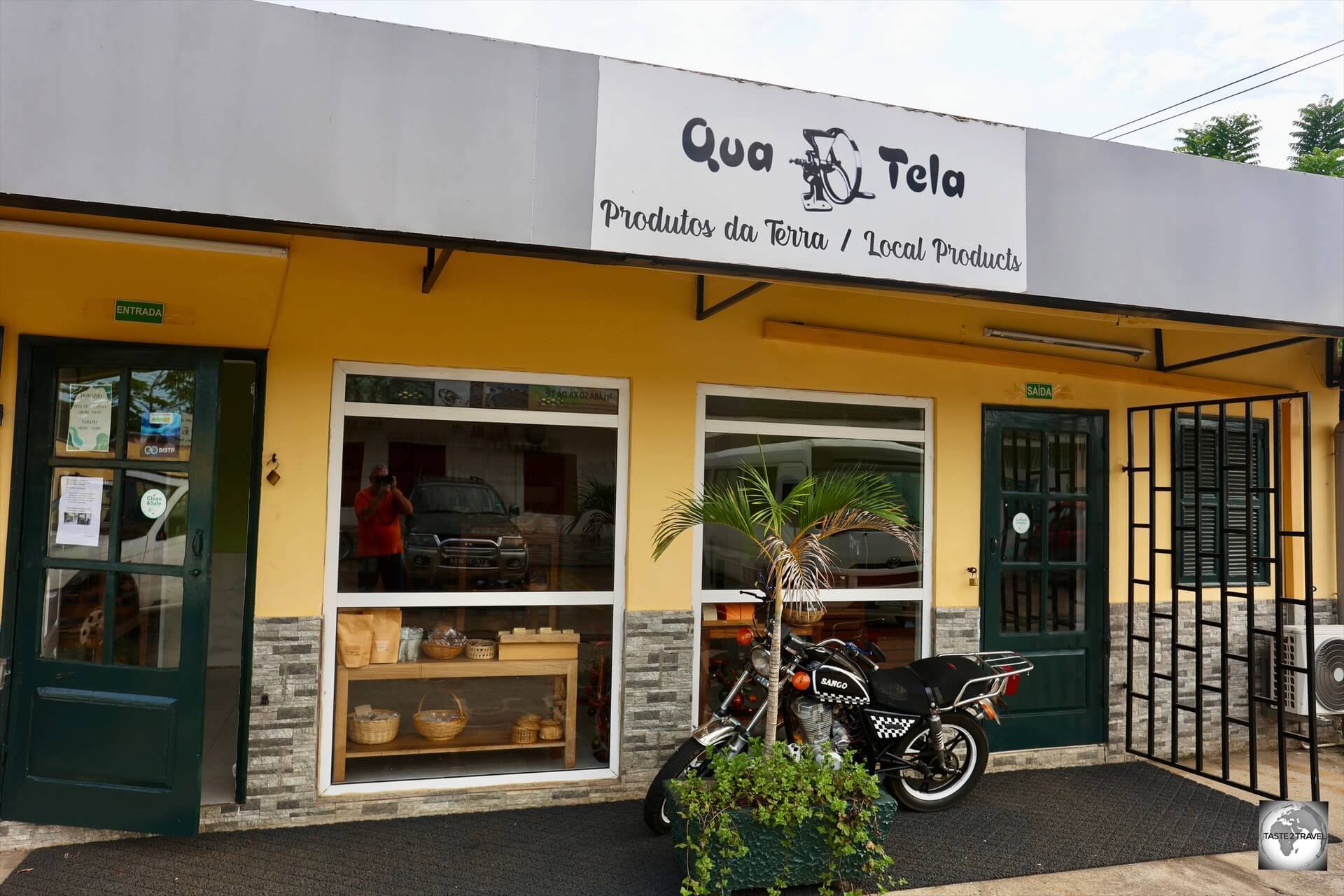
Located in downtown São Tomé, Quá Téla is a one-stop shop for all things Santomean.
Located in downtown Sao Tome, Quá Téla is a one-stop shop for all things Santomean.
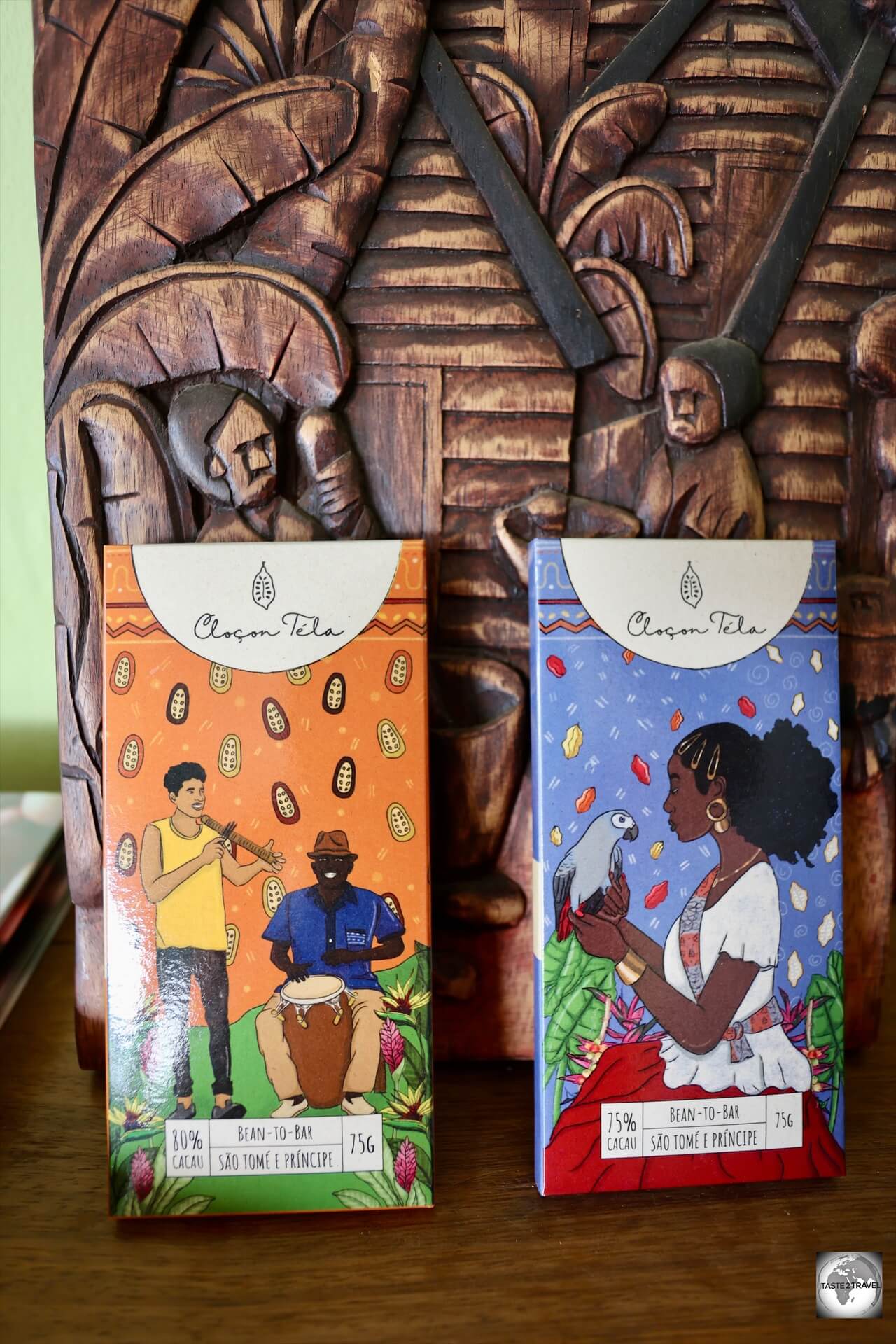
Locally produced chocolate for sale at Quá Téla in São Tomé.
They sell a range of locally produced produce from coffee, chocolate, jams, liquors, spices and much more.

Chocolate, from the Diogo Vaz company, available for purchase at Quá Téla in São Tomé.
In addition to their produce range, they also sell souvenirs such as caps, t-shirts, wooden handicrafts, masks, woven baskets and much more.
This is a great place to shop before leaving the country.
- Opening times: Open Monday to Friday from 8:30 am to 1 pm and from 2:30 pm to 6 pm. Saturday from 9am to 12:30pm.
- Email: quatelastp@hotmail.com
- Telephone: +239 222 7633
- Address: EN2 road, São Tomé
Sightseeing
São Tomé and Príncipe were uninhabited prior to colonisation by the Portuguese in the 1490s.
Since then, much of the landscape has remained unchanged or, where former plantations once stood, reclaimed by the rainforests.
The islands are covered by lush rainforests and, with a small population, very little development, and very few tourists, they remain an untouched veritable tropical paradise.

Portuguese colonial-era architecture in downtown São Tomé.
Among the human-made sights on the islands are the many Portuguese-era colonial buildings.
Totally unrenovated, many of these former architectural wonders remain largely unchanged from colonial times.
Essential for every visitor is a tour of one of the islands’ colonial-era plantations – roças – which lie in many different states, from centuries-old buildings slowly being overgrown by rainforest, to lovingly refurbished ones operating as bed-and-breakfasts.
Tour Guides
On both São Tomé and Príncipe islands, I organised a rental car through my guest house.
In both instances, I was offered a driver/ guide which I willing accepted.
Touring the islands can be difficult due to a lack of signage and the poor infrastructure.
Dirt roads in many places are very rough, muddy and almost impassable.
However, with a local driver, who is use to the conditions, travel is made easier.
São Tomé Guide/ Driver

My guide on São Tomé, Elisio Nunes took me to this remote, hidden location which offered a spectacular view of the iconic Pico Cão Grande.
When I rented my 4WD through my guest house in São Tomé, it was delivered by Elisio Nunes who is the young, energetic and enthusiastic owner of Sãoto Tour & Cars.
His company can organise day trips to any part of São Tomé, including boat excursions, and rental cars.
Day trips start at EUR €60, while a rental car costs from EUR €40 per day.
While I intended to do a self-drive of the island, I realised that paying a little extra to have Elisio do the driving and guiding would be beneficial.
As an added bonus, Elisio speaks perfect English which is rare for a Santomean.
At the time of my visit, Elisio was busy organising a local delegation who were about to travel to Macau (a journey of three days) to attend a tourism summit. Elisio was acting as the head of the delegation!
Elisio is a very knowledgeable guide who managed to take me to some hidden places on São Tomé, including one remote beach which offered the best view of the iconic Pico Cão Grande.
Many of the more interesting sights lie at the end of unmarked, muddy, dirt, tracks which wind their way through the dense rainforest.
I can attest that having Elisio as my driver/ guide totally enhanced and enriched my experience of São Tomé.
Contact Details:
- Website: https://www.saototourcar.com/en
- WhatsApp: +239 9945184
- Instagram: https://www.instagram.com/saototour/
- Email: nuneselisio49@gmail.com
I would highly recommend engaging the services of Elisio and his company for your trip to São Tomé.
Príncipe Guide/ Driver

My host, and guide, on Principe, Carlos Manuel, enjoying a drink at the Hotel Roça Sundy.
While on Principe, I rented a 4WD through my guest house, Residencial Brigada, which is owned by the very busy, and highly entrepreneurial, Carlos Manuel.
A native of Principe, who lived for many years in Lisbon, Carlos is very active on the local tourism scene and can organise any aspect of a trip to Principe.
He offers airport transfers, comfortable accommodation, car rental, guiding, sightseeing trips by land and sea, plus his talented wife cooks the most amazing meals, using produce from the local market.
All meals are served with freshly squeezed fruit juices.

Exploring Principe with my rental car and my guide/ driver – Rodrigo Lopes.
The cost of his one rental car is EUR €50 per day with an additional fee for a driver/ guide.
Normally Carlos (who speaks English) would offer his services as a driver/ guide.
However, on the day I hired my car, Carlos was busy in the morning so he offered me another guide, Rodrigo Lopes.
After lunch at the guesthouse, Carlos then took over, providing me with an afternoon of sightseeing.
Video:
Exploring Principe in my rental car with my driver/ guide Rodrigo Lopes.
There are many unmarked, muddy, dirt tracks on Principe and many of the best sights are to be found at the end of these tracks.
I was pleased that I had a local driver who knew where he was going. You could easily get lost in the dense rainforests on Principe.
Contact Details:
- WhatsApp: +239 9920520
- Instagram: https://www.instagram.com/brigada.residencial/
São Tomé Island
São Tomé City

A view of the Atlantic coast in downtown São Tomé.
The capital of São Tomé and Príncipe is also called São Tomé, which in English translates as “Saint Thomas”.
Though a third of the nation’s total population lives here (about 72,000 inhabitants), it feels like a giant village, wonderfully lively and compact.

The Nossa Senhora da Graça Cathedral is located on Praça do Povo (People’s Square) in the city centre.
Most buildings are Portuguese, colonial-era, relics which are in various states of decay which adds a certain amount of rustic charm to the city streets.

Praça da Independencia marks the centre of downtown São Tomé.
The city, which wraps around the waterfront, is easily covered on foot and is very relaxed.
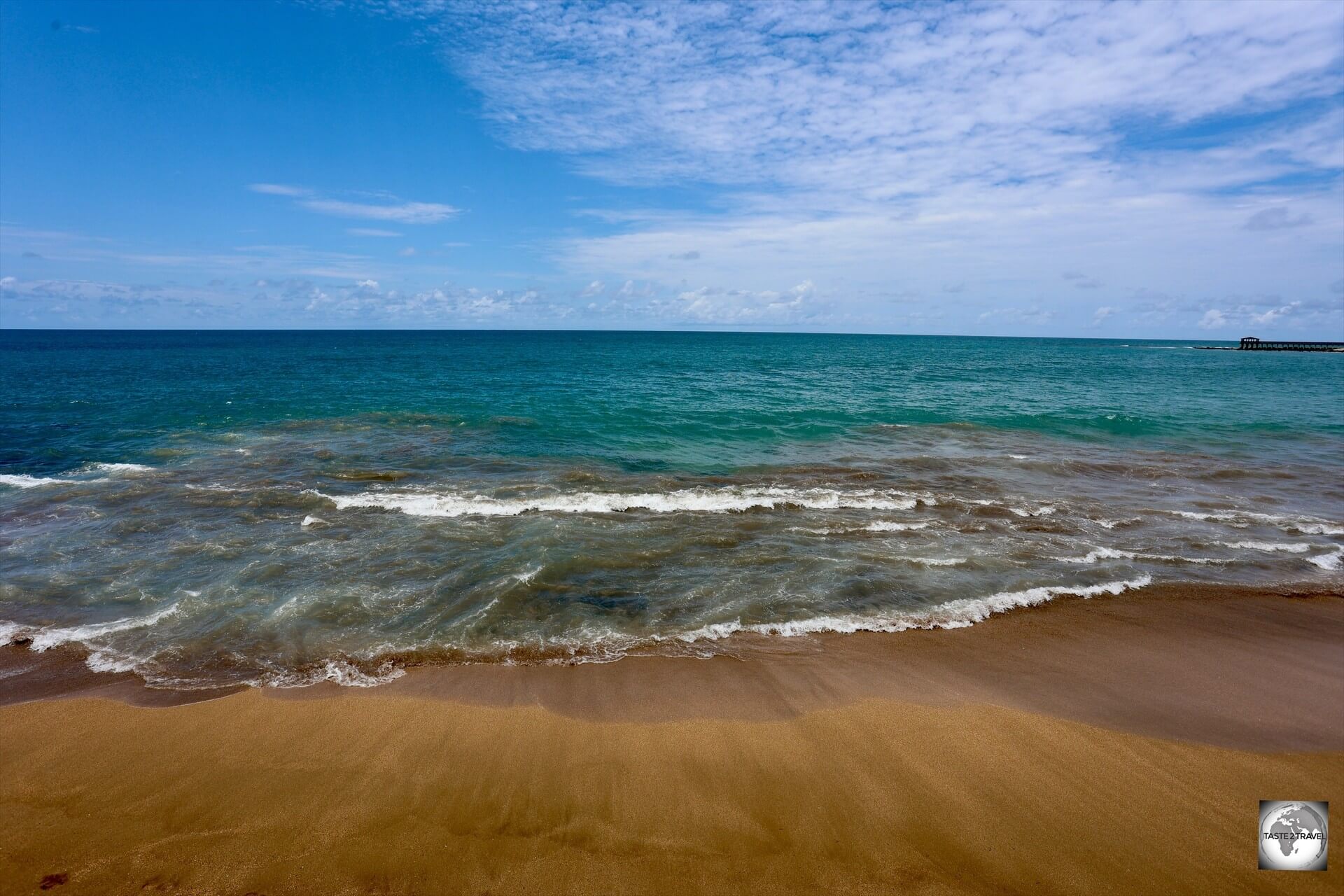
A view of the Atlantic coast in downtown São Tomé.
Crime rates are very low and at no time did I feel threatened or unsafe.

The streets of São Tomé are lined with beautiful, and grand, Portuguese colonial-era buildings.
I was able to walk around with my camera and take photos of almost everything – although the guards outside the Presidential Palace will not allow you to take photos of the palace.

A park in downtown São Tomé.
The locals, who see very few tourists, are very friendly and welcoming.
Nossa Senhora da Graça Cathedral

Dating from the 15th century, the Nossa Senhora da Graça Cathedral (Our Lady of Grace Cathedral) is one of Africa’s oldest churches.
While fairly humble as cathedrals go, the Nossa Senhora da Graça Cathedral (English: Our Lady of Grace Cathedral) is one of Africa’s oldest, and a testimony to persistence, as it has been destroyed and rebuilt numerous times in its 400-year history.

A view of the interior of the Nossa Senhora da Graça Cathedral, also known as the Cathedral of São Tomé.
Construction of the first church was started at the end of the fifteenth century. This original church was situated near the present cathedral.
A larger cathedral was constructed between 1576 and 1578, during the reign of King Sebastian of Portugal.

A view of the altar at the Nossa Senhora da Graça Cathedral in São Tomé.
In 1784, the cathedral was in need of renovation and, in 1814, was rebuilt at the initiative of the local population.

The walls of the cathedral are lined with Azulejo a form of Portuguese painted tin-glazed ceramic tilework.
The last modification was made in 1956, when the church was remodeled in an eclectic revival style, with a neo-Romanesque main façade.
Given the limited opening hours, its best to visit whenever you see the doors open, which is usually for the midday mass.
San Sebastian Fort / National Museum

San Sebastian Fort houses the National Museum.
Built in 1575 by the Portuguese, Fort São Sebastião (San Sebastian Fort) was fully refurbished in 2006 and is now home to the São Tomé National Museum.

Built in 1575 by the Portuguese, Fort São Sebastião (San Sebastian Fort) was fully refurbished in 2006.
The fort is located on the waterfront, in the northeastern part of the city centre, at the southeastern end of Ana Chaves Bay.
The small museum contains religious art and colonial-era artifacts. This is the only history museum in the country.

Statues of the three Portuguese explorers who discovered São Tomé stand in the small praça in front of San Sebastian fort.
Outside of the fort stand three statues of the discoverers of São Tomé – João de Santarém, Pêro Escobar, and João de Paiva.
Shortly after independence, the statues were relocated here from other squares in the city so as not to remind the residents of the colonial past.
São Tomé Island – East Coast
Clothes Washing

Clothes washing is normally done in the rivers on São Tomé
Clothes washing in the countryside in Sao Tome is mostly done in the rivers – along with dishwashing and sometimes bathing.

Clothes washing in the countryside in Sao Tome is mostly done in the rivers.
Once the clothes have been washed, they are laid out on the hot river stones to dry.

Laying out the wet clothes to dry in the sun on the hot river stones.
This is not an unusual practice in Africa, but the pristine, natural, environment of São Tomé is unique in Africa.
Roça de Água Izé

The residential area of Roça de Água Izé, which was once used to house the many thousands of plantation worker’s.
One of the highlights of São Tomé is Roça Água Izé (Água Izé plantation), the first, and the most significant, of the cocoa plantations which were developed on São Tomé by the Portuguese.

A view of the main production facility at Roça Água Izé which today serves as an art gallery, library and community centre.
Around the turn of the 20th century, there were some 150 plantations on São Tomé and Príncipe.

A former workshop at Roça Água Izé, has now been repurposed as a mechanic’s workshop.
Set up by the Portuguese for the production of cocoa and coffee, these estates were self-contained, self-sufficient universes, operating largely outside the colonial administration’s remit.
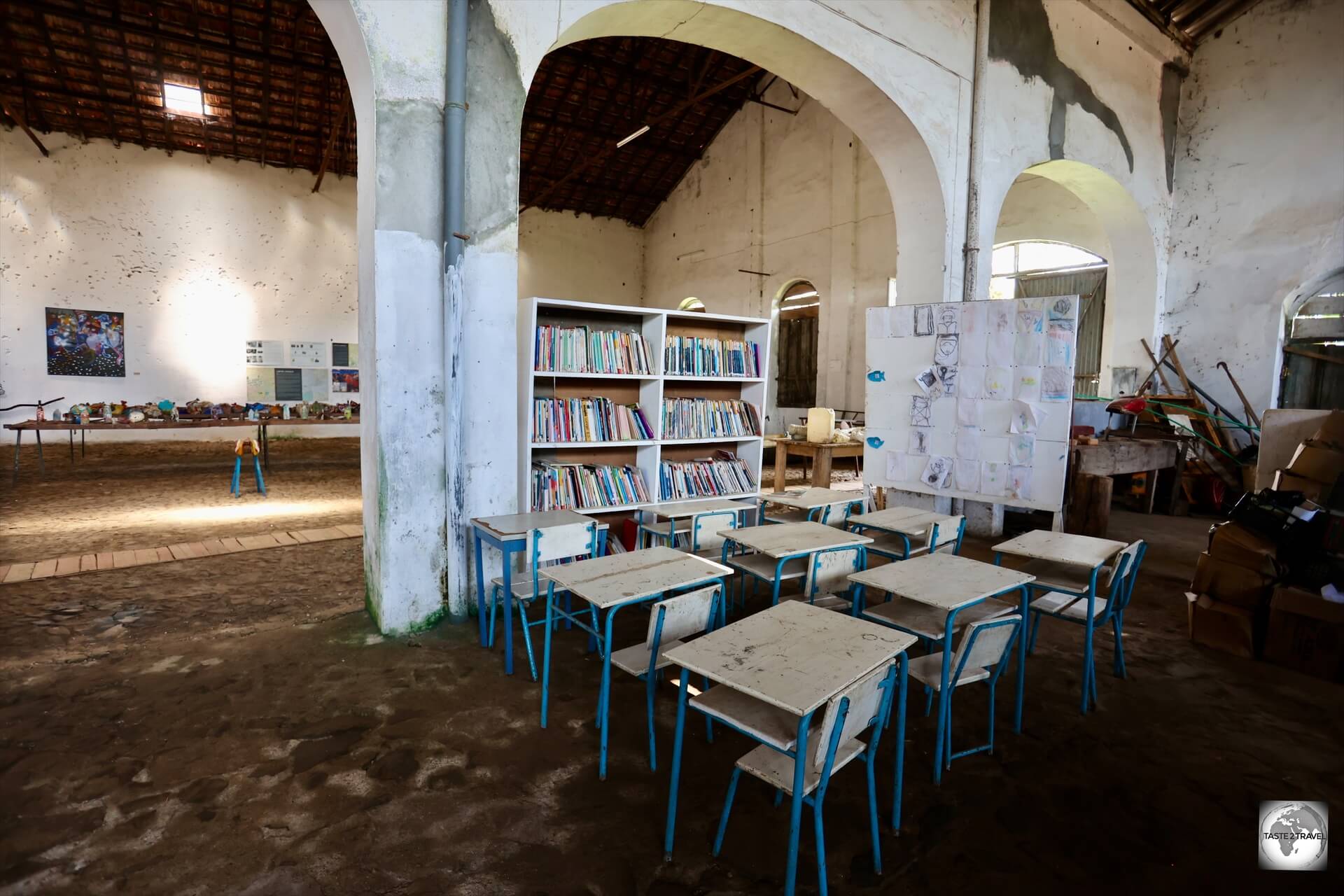
A community library, and classroom, have been installed inside the abandoned production facility at Roça Água Izé.
Roça Água Izé is where commercial cocoa production first started on São Tomé in the mid 19th-century.
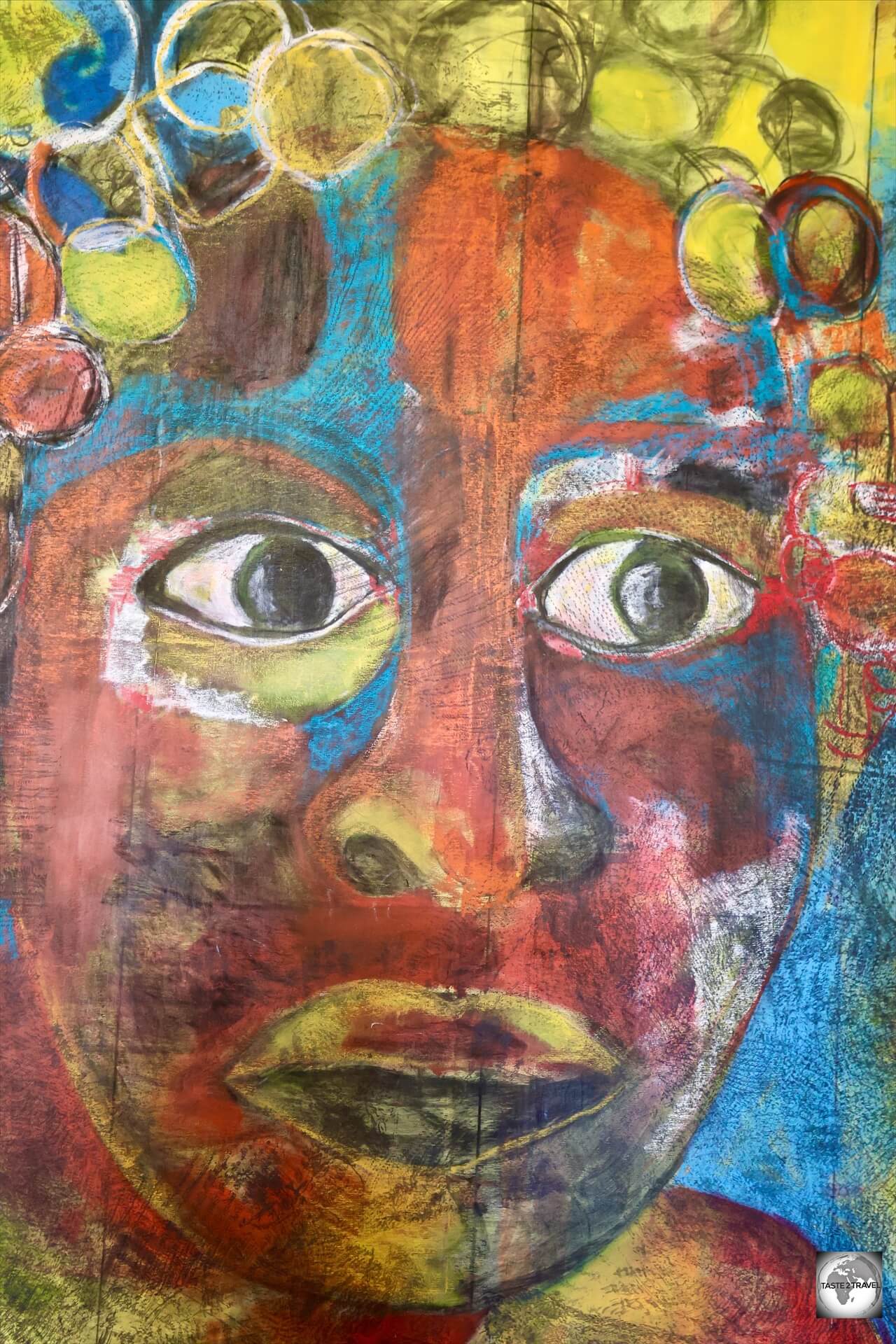
Art work adorns the wall of the former production facility at Roça Água Izé.
When the man responsible for introducing cocoa to the islands, João Maria de Sousa e Almeida, was made First Baron of Água Izé in 1868, he was the first mulatto nobleman in the Portuguese colonies.

The walls of the former production facility at Roça Água Izé have been converted into gallery space where local artists display their works.
Roça Água Izé once housed thousands of workers, many of whom were imported from Angola and Cape Verde.

A view of one of the former stove-houses at Roça Água Izé.
The plantation used to be a large complex with warehouses, a production facility which housed steam-operated machinery, a railway and the best hospital in this part of the world!

A view of the main production facility at Roça Água Izé, which still houses the old steam-driven equipment.
The main production facility, which still houses the old steam-driven equipment, has been converted into a multi-use art gallery, library and community centre.

An artisanal shop has been installed on the old processing equipment at Roça Água Izé.
In 1884, Água Izé had 50km of internal railway lines running through its 80km2 territory and 50 European employees overseeing 2,500 Angolan contract workers.
During its peak production period, cocoa from the plantation was exported to Portugal, from where it was then shipped to all corners of Europe.

In its prime, Roça Água Izé had 50km of internal railway lines running throughout the estate.
With independence in 1975, the world of the roças changed forever as some 200 plantations were nationalised.
While this move was widely supported, a lack of subsequent investment and dip in production saw many of the facilities fall into disrepair.
Today, the plantation has ceased production with many of the buildings now laying in various states of decay, slowly being consumed by the encroaching rainforest.
Most of the abandoned buildings are now occupied by squatters (descendants of the former plantation workers), who eke of an existence by cultivating the remaining cocoa and coffee plants.
Getting there: The roça appears on the roadside on the EN-2 just south of the km-16 marker.
Roça de Água Izé Hospital

My rental car parked outside the abandoned Roça de Água Izé Hospital, once rated as the biggest and best hospital in central Africa.
Built by the Portuguese in 1928, Roça de Água Izé Hospital was once considered to be the biggest and best hospital in central Africa.

A view of the 1st floor staircase at the former Roça de Água Izé Hospital.
Known for its impressive entrance staircase, the most famous building in the Água Izé plantation is now abandoned and in a state of extreme disrepair.

A view of the upper, rear, section of the former Roça de Água Izé Hospital.
The now dark, dank and unlit rooms of this once marvelous facility are occupied by dozens of poor, squatter, families who try to make a living from growing crops on the surrounding land and charging the occasional tourist a small fee to allow access.
One the day we visited, the residents were busy washing their clothes, laying their laundry out to dry one the 1st floor balcony.

A view of the, now roofless, male ward at Roça de Água Izé Hospital.
The former hospital wards, which are located at the rear of the hospital are now roofless and totally abandoned.

A view of the, now roofless, female ward at Roça de Água Izé Hospital.
The whole complex is truly impressive and it’s easy to imagine, in the not-too-distant past, nurses and doctors tending to their patients in the various rooms of this hospital.

A view of the rear of the former Roça de Água Izé Hospital, with the now roofless wards on the left side.
The hospital is located on a hill which overlooks the entire plantation estate.

A view out to sea from the 1st floor of the former Roça de Água Izé Hospital.
No doubt the elevated site was chosen as it receives a direct sea breeze which would have been beneficial to the many patients.
Praia Izé Viewpoint

A panoramic view of Praia Izé from the mirador snack shop.
Just in front of the abandoned hospital, a short garden path leads to a snack shop which affords spectacular views of Praia Izé and beyond.
Boca do Inferno (Mouth of Hell)

The Boca do Inferno (Mouth of Hell), is a small blowhole on the east coast of São Tomé.
Immediately south of the plantation, a side road leads to Boca do Inferno (Mouth of Hell), a small blowhole.
Video:
A view of the Boca do Inferno on a calm day.
When the condition of the sea is right, water is pressed through the natural rock channel and through a hole, which sends a fountain of sea water many meters into the air.

A mask seller at the Boca do Inferno, who managed to sell me this mask for €15.
There are several souvenir stands at the blowhole where locals sell hand carved, colourful masks, other wood carvings and refreshing coconuts.

A view of the east coast, near Boca do Inferno.
Praia das Sete Ondas

A view of Praia das Sete Ondas, a popular surfing beach.
Continuing south along the east coast road, the next stop was the popular surfing beach known as Praia das Sete Ondas (Seven Waves Beach).

A lonely volcanic boulder is a feature of Praia das Sete Ondas.
This grey-sand beach is named after its sets of perfect waves which draws surfers from around the world.

Praia das Sete Ondas is a beautiful, volcanic sand beach.
The beach is located just south of the KM-20 marker on the EN-2.

Praia das Sete Ondas (Seven Waves Beach) is named after its sets of perfect surfing waves.
Obô Natural Park

A painting of Pico Cão Grande by a local artist.
Obô Natural Park, also known by its original name Parque Natural Ôbo, is a natural, national and very important park which is located in the southern part of the island of São Tomé.
There are plenty of gorgeous features that Obo has to offer, however, the most famous is the Pico Cão Grande, a soaring volcanic plug of epic proportions.
In 2012, a section of rainforest on Principe was added to the park, increasing the area of the park to 300 square km (116 square mi).
Pico Cão Grande

The iconic <>i>Pico Cão Grande (“Great Dog Peak”) is a landmark needle-shaped volcanic plug peak in São Tomé.
One of the highlights of the Obo Natural Park is the iconic Pico Cão Grande.
Located in the south of São Tomé Island, about a one-hour drive south of the capital, this iconic volcanic plug was formed around three and a half million years ago by magma solidifying in the vent of an active volcano.

A view of Pico Cão Grande from the main road – highway EN2.
Its summit is 663 m (2,175 ft) above sea level, and it rises about 370 m (1,210 ft) over the surrounding terrain.
Climbing the peak is technically challenging due to slippery moss growing on the volcanic stone and the presence of snakes.
Only a few teams of rock-climbing specialists have managed to summit the peak with one team sustaining snake bites. Ouch!
Praia Grande

The isolated Praia Grande provides one of the most stunning views of Pico Cão Grande.
Located inside Obô Natural Park, the isolated and lonely Praia Grande provides one of the most stunning views of Pico Cão Grande, with a river leading your view directly to the peak which lies in the distance.
While the view of Pico Cão Grande along the road, and from the view point, is very good, the view from Praia Grande is exceptional.
São Tomé Island – Interior
Roça Monte Café

Roça Monte Café (Coffee Mountain Plantation) is a coffee plantation located in the lofty interior of São Tomé Island.
Home to 684 souls, Roça Monte Café (Coffee Mountain Plantation) is a plantation located in the lofty interior of São Tomé Island, just 6-km inland from the town of Trinidade.

Artwork in the museum at Roça Monte Café.
Situated in mountainous terrain, at an elevation of 670-metres (2,198 ft), the cool and inviting Roça Monte Café is perfectly placed for the cultivation of coffee.

Roça Monte Café was established in 1868, making it one of the oldest plantations on São Tomé.
Established in 1868, this coffee plantation is one of the oldest plantations on São Tomé, and, unlike most plantations, is fully functioning and thriving.

One of the cuter inhabitants of Roça Monte Café.
One of the main attractions of Monte Café is its visitor’s centre, coffee museum and the attached cafe.

A view of the coffee museum at Roça Monte Café.
Visitors can learn about the history of coffee production in São Tomé, where both Arabica and Robusta beans are grown.

Steam-operated equipment at the coffee museum at Roça Monte Café.
The museum has a series of exhibitions that show the coffee production process, from the plantation to the cup.
Following the tour, visitors can relax in the adjacent cafe with a complimentary coffee. Very smooth and delicious!

Coffee heaven – the coffee shop at the Monte Coffee plantation.
While there are plenty of places to purchase coffee in São Tomé, the best place is direct at the source – the Monte Coffee plantation.

Locally produced coffee for sale at the Monte Coffee plantation.
This historic roça has been producing the finest of coffee beans since 1858 and is especially known for its strong arabica beans.

Roça Monte Café – Coffee Mountain plantation!
In the village at Roça Monte Café, Firma Efraim is a coffee shop, guest house and restaurant, offering meals, accommodation and coffee tasting.

Firma Efraim is a coffee shop, guest house and restaurant, offering meals, accommodation and coffee tasting.
Getting there: The entrance to Roça Monte Café is located on the right about 6-km inland from Trindade on the EN-3.

Cascata Sao Nicolau

The beautiful Cascata São Nicolau (Saint Nicholas Waterfall), an easily accessible, 60-metre-high waterfall.
The central highlands have many waterfalls, but Cascata São Nicolau (Saint Nicholas Waterfall) is probably one of the easiest to reach, as it’s right next to the road.
This 60-metre-high waterfall, is hidden by dense vegetation in the middle of a dense forest.

A natural pool at the base of Saint Nicholas Waterfall is an ideal place to cool off.
There is a natural pool at the base of the waterfall, where you can cool off.

Robusta coffee beans growing on the side of the road near Cascata Sao Nicolau.
The falls are located along a winding, bumpy mountain road, just beyond Roça Monte Café.
The road is lined with Robusta coffee plants which were full of fruit at the time of my visit.
São Tomé Island – West Coast

A view of a west coast beach, with many traditional wooden fishing boats, on São Tomé.
As you travel along the north-west coast of São Tomé, just south of Roça Diogo Vaz, which is famous for its chocolate products, a magnificent stone beach comes into view.

A view of the west coast of São Tomé, near to the Santa Catarina tunnel.
Along this beach, and other beaches on the west coast, traditional dug-out fishing boats lie in neat rows.
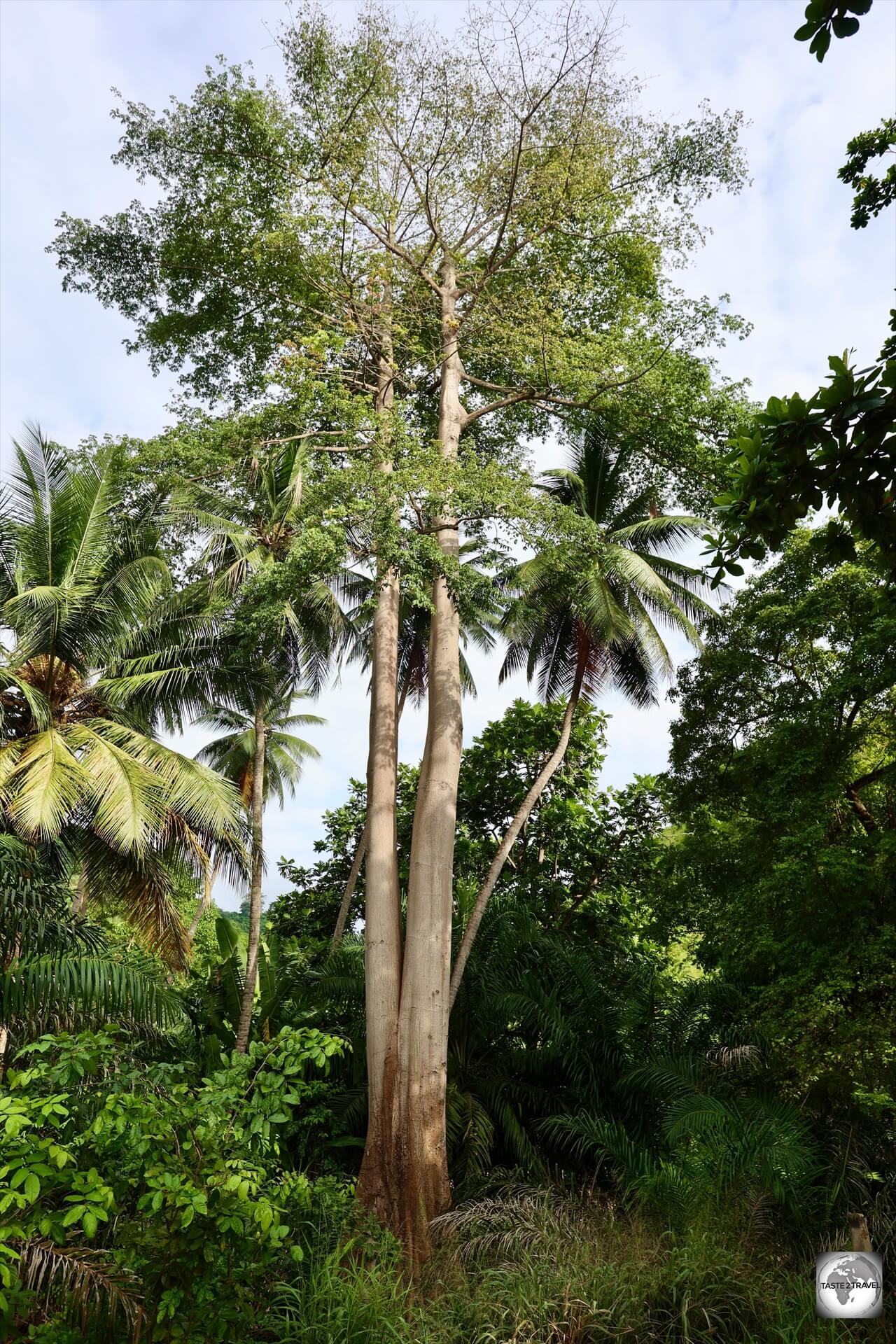
The west coast of São Tomé is lined with many majestic Ceiba trees.
These wooden, hand-carved fishing boats are made from the long, straight trunk of the Ceiba tree, many of which can be seen, standing like towering sentinels, along the coastline.

Wooden canoes on the west coast of São Tomé.
Santa Caterina Tunnel

A view of the very photogenic Santa Catarina Tunnel.
Driving in Sao Tome is really spectacular and the northwest coast road isn’t any different.
For long sections, the road follows the sparsely populated coast, offering panoramic views of the many stone beaches.

The Santa Catarina Tunnel, the only road tunnel on São Tomé and Príncipe.
Near the end of the road, before the village of Santa Catarina, is the only road tunnel in Sao Tome.

The Santa Catarina Tunnel allows the coastal road to pass through a narrow coastal mountain.
Built by the Portuguese, the 20-metre-long Santa Catarina Tunnel is the only road tunnel on São Tomé and Príncipe.
Principe

A view of the lush, green Principe Island from the Terreiro Velho plantation.
A volcanic island, which was formed 31 million years ago, Principe was uninhabited when discovered by the Portuguese on the 17th of January 1471.
Originally named “Saint Anthony”, the island was later renamed Príncipe (“Prince’s Island”) by King John II of Portugal in honour of his son Afonso, Hereditary Prince of Portugal (1475–1491).
Home to just 7,324 inhabitants, Principe Island is a small, sparsely populated, heavily eroded volcano.
The Chocolate Islands

Cacao plants at the Terreiro Velho plantation on Principe.
As you travel around Principe, you will find cacao trees growing wildly throughout the rainforests on the island, especially at the very wild Terreiro Velho plantation which is home to Claudio Corallo chocolate.
Nicknamed, The Chocolate Islands – in 1913, São Tomé and Príncipe were the world’s largest producer of cocoa.
After achieving independence in 1975, their production saw a significant decline due to their lacking infrastructure.
Today, small boutique chocolate manufacturers, such as Claudio Corallo, are producing world-class, single origin chocolate, using cacao beans from plants which have existed for decades in this remote, pristine environment.

Besides cacao and coffee plants, Terreiro Velho plantation is home to many wild pepper plants.
The old plantation grounds at Terreiro Velho have been taken over by the lush tropical jungle.
Throughout, coffee, cacao and pepper plants can be found growing in areas where the sunlight breaks through the canopy.
Video:
Exploring the Terreiro Velho plantation in my rental car with my driver/ guide Rodrigo Lopes.
The southern part of the island is now a UNESCO Biosphere Reserve, which includes the entire emerged area of the island of Príncipe, and its surrounding islets.
Principe is the closest you will get to an untouched paradise, anywhere in the world.

A view of stunning Praia Banana (Banana Beach), one of the highlights of Principe.
This little-known island provides unspoiled beauty, covered in a canopy of green, broken by spires of primordial rock.
The island offers fantastic beaches, rainforests, snorkeling, fishing, birdwatching and a handful of interesting (if expensive) accommodations.

A typical, Portuguese-built, cobbled road on Principe.
While both islands have their natural rewards, Príncipe offers an abundance of pristine nature and should not be missed!
Of the total number of visitors which venture to São Tomé and Príncipe, only 5% of them make the side trip to Príncipe.
I highly recommend making the trip and spending at least a few days on this charming paradise island.
Getting there:
Príncipe is located 173 kilometres (107 mi) north-east of São Tomé and can be reached on twice daily flights from São Tomé Airport.
Santo Antonio

The Church of Our Lady of the Rosary is the principal church in Santo Antonio, Principe Island.
Located on the north-east coast of Principe, Santo António (Portuguese for Saint Anthony), is the main settlement, and only town, on the island.

Relaxing in the main square of Santo Antonio.
The town was founded by the Portuguese in 1502, and was a centre of sugarcane cultivation.

A tiny house in Santo Antonio, Principe Island.
From 1753 until 1852, it served as the colonial capital of Portuguese São Tomé and Príncipe.

Portuguese colonial-era architecture in Santo Antonio, Principe Island.
Due to its previous role as the capital, tiny Santo Antonio is a treasure trove of Portuguese colonial-era architecture – and some more modern, funky, street art.

Street art in Santo Antonio, Principe Island.
Santo Antonio is home to 2,620 inhabitants, which account for about 35% of the island’s total population.

Portuguese post box on the main square of Santo Antonio, Principe Island.
The town is known for its colonial architecture and for its two churches, the Church of Our Lady of the Conception and Church of Our Lady of the Rosary (Portuguese: Igreja de Nossa Senhora do Rosário).
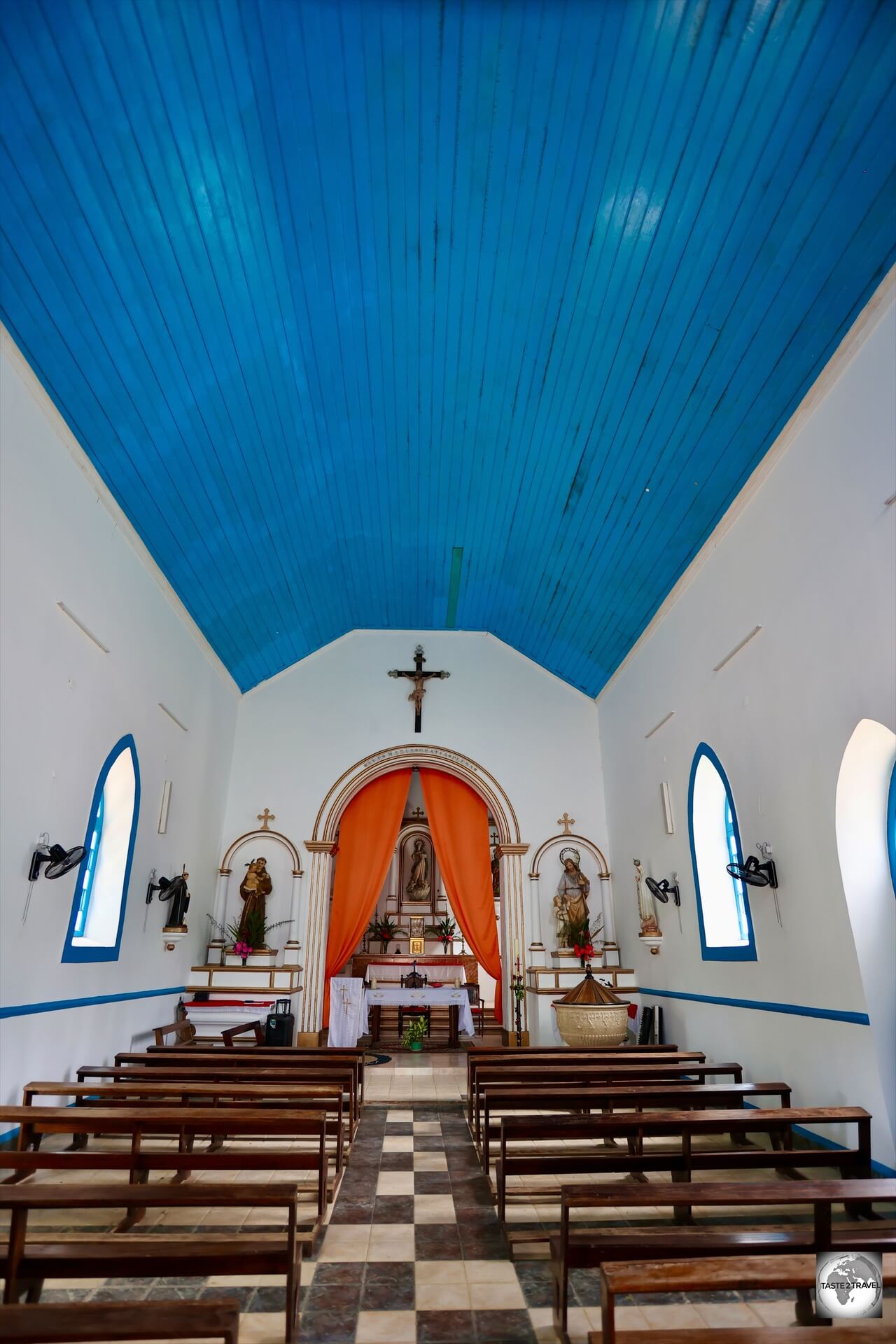
The interior of the Church of Our Lady of the Rosary, Santo Antonio, Principe Island.
Charming and relaxing, Santo Antonio is often called the “smallest town in the world” and is easily covered on foot.

Portuguese cannons and a memorial to Marcelo da Veiga, a local poet, graces the square, which is named after him, in Santo Antonio, Principe.
Praia das Bananas

A view of Praia das Bananas, one of the best beaches on Principe.
Considered to be the best beach, on an island which offers so many stunning beaches, Praia das Bananas (Banana Beach) is named after its curved stretch of golden sand, which is roughly in the shape of the yellow fruit.
This picture-perfect tropical beach is located on the grounds of Roça Belo Monte, a 15-minute walk from the front gate.

A painting, by a local Principe artist, depicts Praia das Bananas.
It is first seen from above, at a clifftop lookout, before descending to sea level, where you’ll find its golden sands, in the shape of a banana, beneath swaying palms.

The beautiful Praia des Bananas.
Hidden beneath the trees are a small bar and lounge chairs.
There is snorkeling at either end, excellent swimming in between, and kayaks available from resort staff.
At the time of my visit, I had this amazingly beautiful beach to myself.
Photography Note:
The only time to photograph Praia das Bananas is in the morning, when the beach is basking in golden sunlight.
In the afternoon, the sun moves behind the beach which places the golden sand and turquoise water in the shadow (as can be seen in my image above).
Praia Bom Bom

A view of Praia Bom Bom, one of a number of remote and secluded beaches on Principe and home to a deluxe resort.
Deluxe Resorts of Principe
Principe is renowned for its deluxe resort accommodation, which comes at a (high) price!
There are three such resorts on the island, all of which are managed by HBD Principe, a company which is owned by South African billionaire Mark Shuttleworth.
Praia Bom Bom is home to ‘Bom Bom‘, which at the time of my visit was closed for a complete renovation. The resort is due to reopen in September, 2024.
The other HDB resorts on Principe include Sundy Praia and Roça Sundy.
In addition to the Principe properties, HDB also offer Omali Lodge on São Tomé.
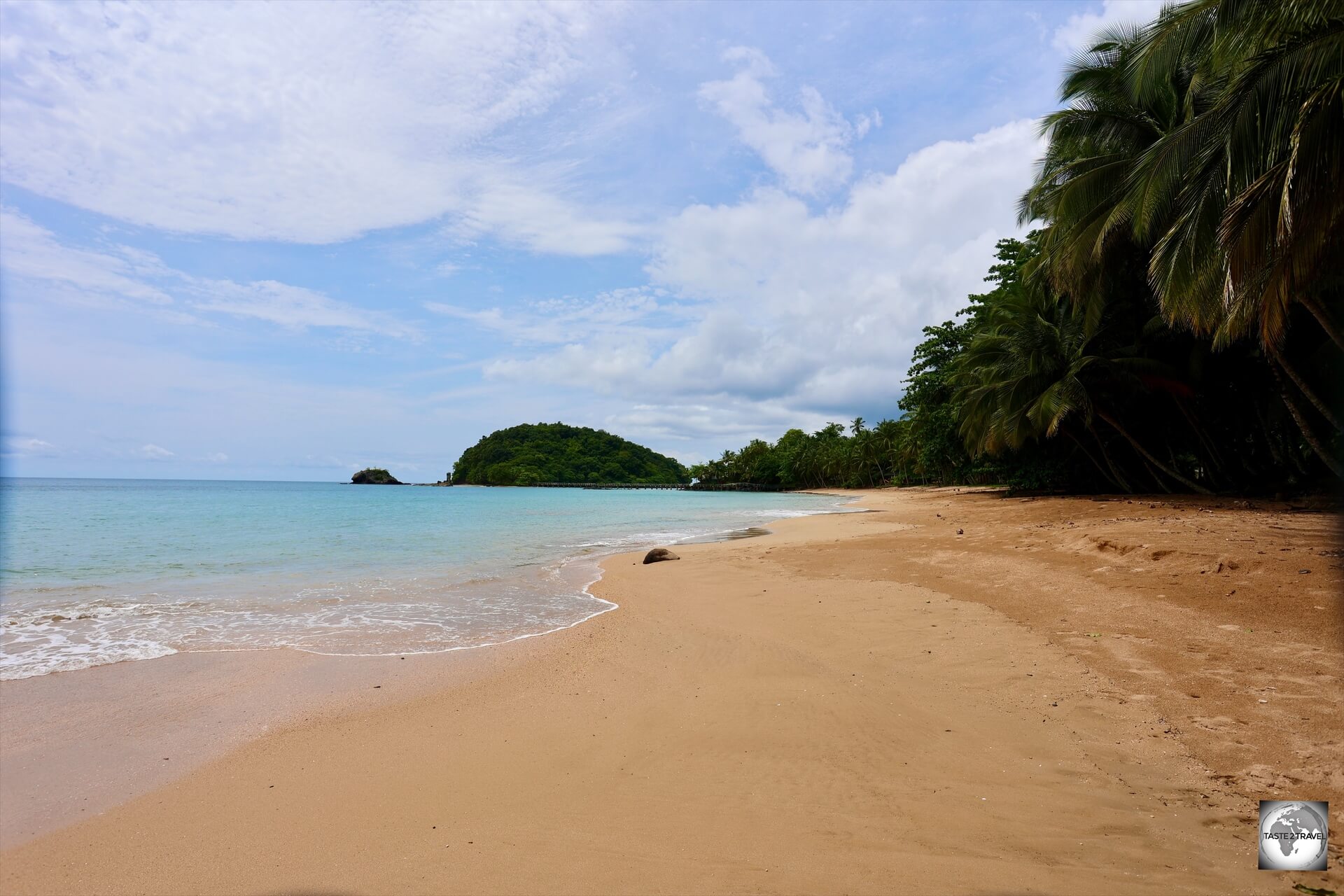
A view of Praia Bom Bom, and the small islet which is home to a deluxe resort.
Praia Abade

A view of the very quiet Praia Abade which lies to the east of Santo Antonio.
Located 7-km due east of Santo Antonio, the very quiet Praia Abade is home to a rocky stretch of beach which is completely surrounded by lush, emerald-green, rainforest.

The El Farolito snack shop at Praia Abade.
Snacks and drinks are available from El Farolito (translates as ‘The Lantern’), a small snack shop which lies in the shade of swaying palm trees, directly opposite the beach.

Also at El Farolito, a small souvenir stand offers locally produced crafts at totally reasonable prices.

A view of the fishing village at Praia Abade.
Praia Abade is home to a small population who live in a picturesque fishing village.
Hotel Roça Sundy

The drawing room is a highlight of Eclipse house at the Hotel Roça Sundy on Principe.
One of three superb offerings on Principe by the HDB hospitality group, Hotel Roça Sundy is a luxury hotel, full of character and offering loads of old-world charm.

A view of the beautiful ceiling, which is made from local marapião wood, and the reception area at Hotel Roça Sundy.
The hotel occupies the grounds of the former Roça Sundy, which was established in 1822 and has the distinction of being the first cocoa plantation of the whole archipelago.

A view of the front entrance of Eclipse House at Hotel Roça Sundy.
Located 5 km northwest of the island capital of Santo António, this beautiful, deluxe boutique hotel features 18th and 19th-century buildings which were built by the Portuguese.

Giant sketches of endemic birds feature on the balcony walls at Hotel Roça Sundy.
The buildings, which are interspersed with large courtyards, lush gardens and lawns, have been beautifully restored and feature sweeping staircases and ornate ceilings made from local marapião wood.
Roça Sundy is comprised of two beautifully restored buildings: Eclipse House and Cacao House.

Eclipse House, once the hub of the old plantation, now serves as the main building of Hotel Roça Sundy.
Eclipse House, the former hub of the plantation, features the opulent reception area, a drawing room, restaurant and a beautiful terrace where you can enjoy sunset drinks.
Cost: Hotel Roça Sundy offers 15, well-appointed, rooms which cost from €210 per person, per night (based on 2 people sharing).
Scientific Experiment

A plaque, at Hotel Roça Sundy, commemorates Arthur Stanley Eddington’s scientific experiment.
Roça Sundy was once the sight of an historic scientific experiment when, in 1919, the English scientist, Arthur Stanley Eddington, and his team visited Príncipe to test Einstein’s General Theory of Relativity.
They based themselves at Roça Sundy, and, during a total solar eclipse on the 29th of May 1919, they took photos of a star field around the sun.
They compared these photos to ones taken during the night, in Oxford, England, in February of the same year.
The aim of the expedition to Principe was to measure the gravitational deflection of star-light passing near the Sun.
The value of this deflection had been predicted by Albert Einstein in a 1911 paper.
The expedition allowed the scientists to test Einstein’s theory which was proven to be correct, that star-light is indeed deflected by the light of the sun.
A small museum on the grounds of the hotel features displays which detail this historic event.
Hotel Roça Belo Monte

The restored plantation manor house at Roça Belo Monte, Principe Island.
Located in the north-eastern corner of Príncipe Island, Hotel Roça Belo Monte is a former cacao plantation which was established by the Portuguese in 1922.
The plantation was shuttered at the time of independence but has since been revived in the form of a beautiful boutique hotel.
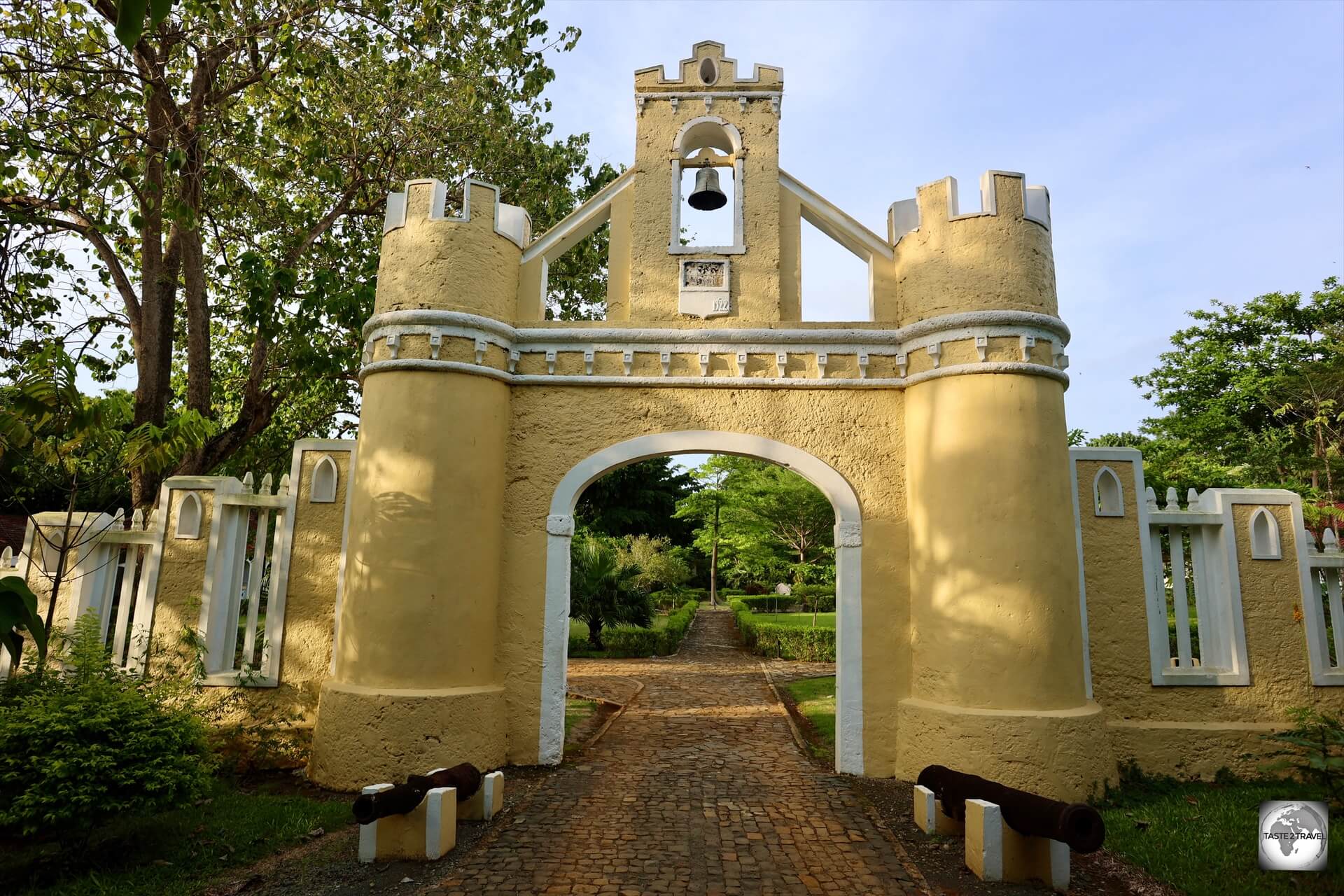
The crenellated entrance gate at Roça Bela Monte Hotel.
Entrance to the former plantation grounds is through a crenellated gateway.
Beyond this grand entrance, the hotel offers twenty rooms in different buildings, a bar and restaurant with terraces, a swimming pool and panoramic views over the surrounding rainforest.
The plantation grounds also include the iconic Praia Banana.
Scuba Diving

Scuba Diving can be arranged through Dive Tribe who are based at the Pestana São Tomé Hotel.
The one scuba diving shop I found on Sao Tome was Dive Tribe who are based at the Pestana São Tomé Hotel.

The ‘Dive Tribe’ scuba diving shop at the Pestana São Tomé Hotel.
A single dive, including all equipment, costs EUR €55, while 4 dives costs €212.

Scuba diving price list, at Dive Tribe in São Tomé.
At the time of my visit, visibility was poor so no diving trips were being organised.
Accommodation

The most inviting pool in the capital – the infinity pool at the Pestana São Tomé Hotel.
The cost of accommodation in São Tomé and Príncipe can range from budget guesthouses to luxury resorts.
Budget guesthouses can cost around $20-$50 per night, while mid-range hotels can cost around $70-$150 per night.
Luxury hotels and resorts can cost upwards of $200 per night.
São Tomé
Pestana Sao Tome Hotel

The best hotel in the capital, the Pestana São Tomé Hotel.
For those seeking more deluxe digs in the capital, the Pestana Sao Tome Hotel is a good choice.

A view of the garden at the Pestana São Tomé Hotel.
Standard rooms at the Pestana São Tomé Hotel start at USD$220 per night.

The boardwalk, at the Pestana São Tomé Hotel.
The only credit card which is accepted is Visa!
Pestana Miramar São Tomé

The Pestana Miramar São Tomé offers comfortable rooms overlooking the sea from US$120 per night.
A sister property to the Pestana São Tomé Hotel is the nearby Pestana Miramar São Tomé, which is located a short, 5-minute, walk from the former hotel.
Rooms at this older property cost from just US$120 per night.
Hotel Central
The best mid-range option in town is the Hotel Central which, as the name suggests, is located in the heart of the old town.
Comfortable and clean rooms cost from US$50 per night on booking.com
Albergaria Porcelana
During my stay in São Tomé, I resided at the, less-than-ideal, Albergaria Porcelana which was recommended by some friends.
A standard room at this budget establishment costs US$30 per night.
I was flooded out during my stay and a truckload of chicken feed, which was stored in the basement, meant a foul stench hung in the air during my stay.
Very unpleasant. I would avoid this establishment.
Principe
Principe island offers some amazingly deluxe resorts, which are hidden away in secluded corners of this quiet island, and cost a small fortune.
The top 3 hotels on the island are owned by the HBD hospitality group, which is owned by South African billionaire, Mark Butterworth.
Top of the list is the immaculate Sundy Praia Lodge, where a one-bedroom villa costs from US$1,350 per night.
Another HDB offering is the charming, old-world Hotel Roça Sundy which is detailed in the ‘Sightseeing’ section above.
Residencial Brigada

A view of my spacious ‘Queen Studio’ room at Residencial Brigada.
During my visit to Principe, I chose to stay at the much more unpretentious, and totally affordable, Residencial Brigada which is tucked away in a side street of Santo Antonio.

The bathroom in my ‘Queen Studio’ room at Residencial Brigada.
The 3-star, Residencial Brigada features accommodation with a garden, free private parking, a terrace and a restaurant.
Owned by the enthusiastic and energetic Carlos Manuel, this cosy guest house offers spotlessly clean and comfortable rooms starting at EUR €57.50 for a single or EUR €70 for two people.
Rates include a delicious breakfast.
Services include airport transfers, free WiFi and delicious, locally-inspired, meals which are prepared by Carlos’ wife – who is an excellent cook.

All meals at Residencial Brigada, including this delicious breakfast, are prepared by Carlos’ wife.
For a more comfortable stay, I recommend spending more to stay in the queen studio.
Also, through Carlos, I rented a 4WD with a local guide/ driver.
The car rental cost EUR €60 per day – plus extra for the driver.
A guide/ driver is essential on an island where many of the sights lie at the end of unmarked, muddy, rough tracks which weave their way through dense jungle.
The Residencial Brigada is a highly recommended option on Principe.
Contact Details:
- WhatsApp: +239 9920520
- Instagram: https://www.instagram.com/brigada.residencial/
Eating Out
Cuisine
The cuisine of São Tomé and Príncipe reflects both African and Portuguese influences.
Common ingredients include fish, seafood, tropical fruits, and vegetables.
Dishes often feature flavors like coconut, palm oil, and spices.
Being an island nation, fish is a staple of the São Toméan diet, often served with breadfruit and mashed, cooked bananas.
In spite of the abject poverty, São Toméans can always count on some sustenance from the wide array of tropical fruits which grow throughout the island.
The rich volcanic soil allows almost anything to grow in profusion.
São Tomé
Xicos’s Café

Xico’s Café in São Tomé offers traditional local, and Portuguese, cuisine served in an authentic, old-world cafe/ art gallery.
Located in downtown São Tomé, the very popular Xicos’s Café offers local, and Portuguese, cuisine at reasonable prices in an old-world café environment.
Named after its owner, Xico, the walls of the café are lined with artworks by local artists, all of which is available for purchase.

A view of Xico’s Café in São Tomé.
The café is especially popular with the expat Portuguese community who come to dine on Portuguese cuisine.
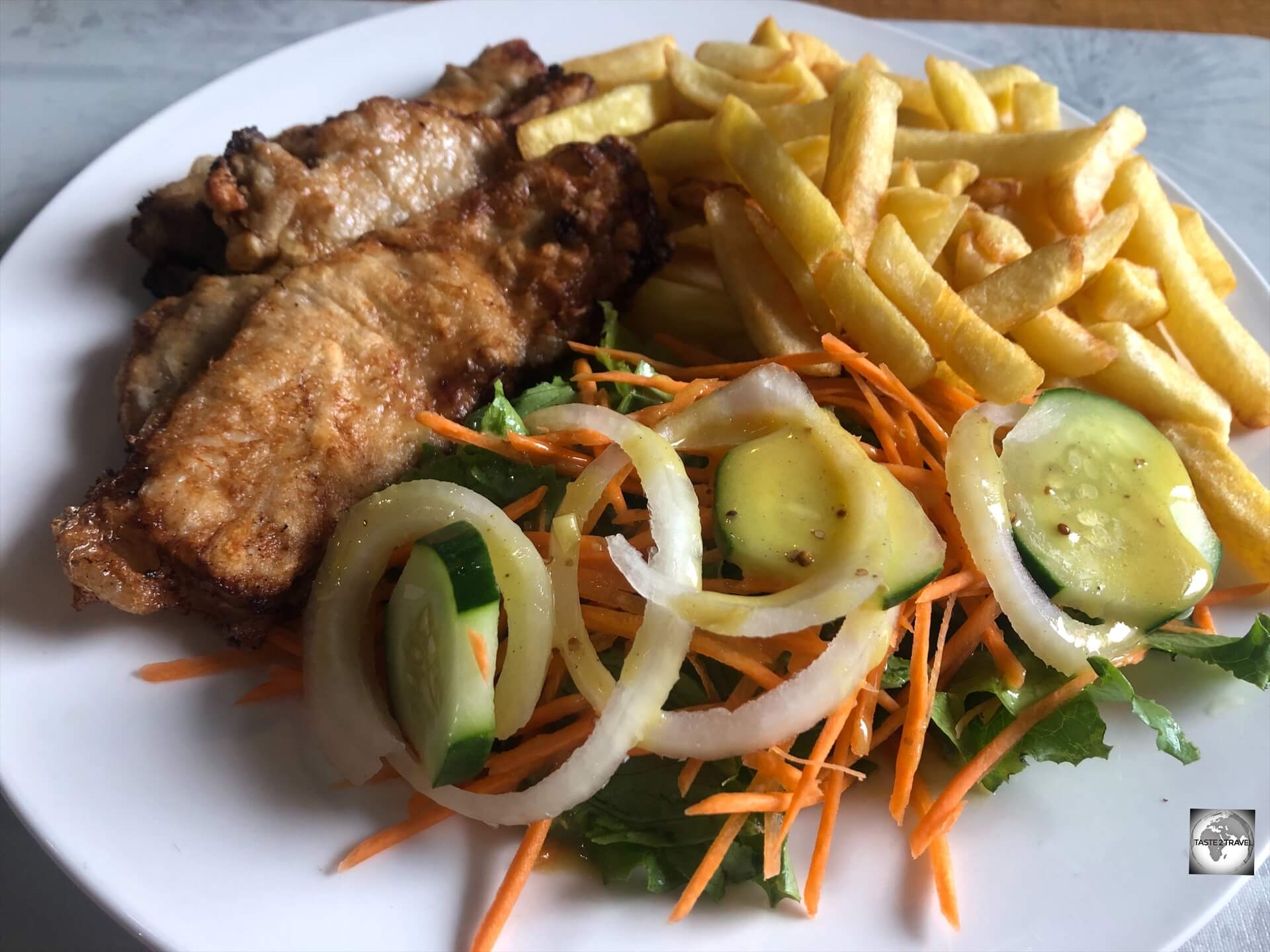
My lunchtime ‘meal of the day’ at Xico’s Café – battered tuna, chips and salad.
The open kitchen is located at the front of the café, allowing you to watch your meal being prepared.
I recommend the ‘meal of the day’ which is served at lunchtime and costs 200 DBs. Standard fare at the cafe includes fresh, local fish with chips and salad.
Open every day except Sunday’s.
Lá Bistro

A view of the popular Lá Bistrô in São Tomé.
Around the corner from Xico’s Café, Lá Bistrô serves similar food with fish, chips and salad being the most popular dish.
For caffeine addicts, this is the one place in São Tomé where you can enjoy a barista-made coffee. The coffees are best enjoyed with one of their fresh cakes, which are baked next door in the bakery.
Highly recommended!
Principe
Armazem Restaurante

The Armazém Restaurante in downtown Santo Antonio.
On an island with very limited dining options, Armazém Restaurante do Roça Porto Real (Warehouse Restaurant Roça Porto Real) in downtown Santo Antonio is housed in a former warehouse, with a seating capacity for over 300 people.
With helpful staff who speak Portuguese and French, the restaurant is busiest at lunchtime, with the most popular dishes being grilled meats and typical Portuguese dishes.
Principe Sightseeing Boat Trips

Boat sightseeing trips of Principe can be booked through the Armazem Restaurante in Santo Antonio.
In addition to the wonderful food, the folks at the Armazem Restaurante can help to organise sightseeing boat trips around Principe Island.
Residencial Brigada
While on Principe, I stayed at the Residencial Brigada where the wife of the owner, Carlos, prepared the most amazing meals, using fresh local produce from the nearby market.
Visa Requirements

Visa policy map of São Tomé and Príncipe.
Many nationalities enjoy visa-free access (highlighted in dark green on the map above) to São Tomé and Príncipe for up to 15 days.
This includes most Europeans, Americans, Canadians, Russians, Japanese and South Koreans.
Other nationalities, such as Australians and New Zealanders, must first apply for a visa.
You can check your visa requirements by consulting the Visa Policy of São Tomé and Príncipe.
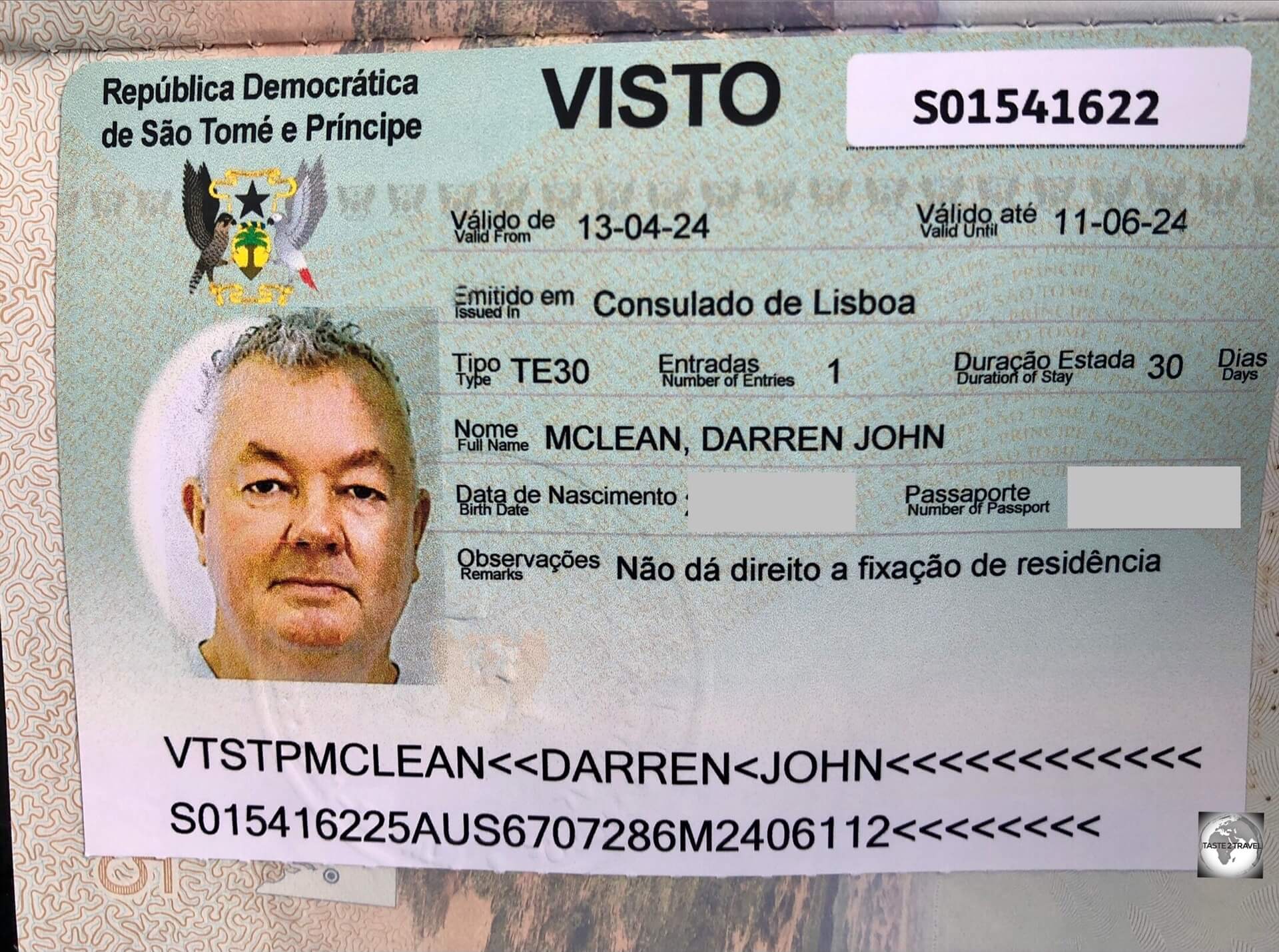
My visa for São Tomé and Príncipe.
Those who require a visa can try applying through the online STP e-Visa website which I found does not work.
I tried twice to submit an application and at no stage did I receive an email or any confirmation that the application had been received.
I never received an e-Visa via the website.
I instead applied in person at the São Tomé and Príncipe embassy in Lisbon where a visa application takes 1 week to process.
Getting There
Air

My STP Airways flight from São Tomé International Airport to Portugal which used a chartered plane from EuroAtlantic Airways,
São Tomé is served by São Tomé International Airport (IATA: TMS) with regular flights to Europe and other African countries.
The airport is located 5 kilometres (3 mi) north-west of downtown São Tomé.
The very small, inadequate, and outdated terminal, is easily overwhelmed whenever flights of the larger airlines (STP Airways and TAP Air Portugal) arrive and depart.

Lining up, outside São Tomé International Airport at 4 am, waiting to pass through the security check.
In order to enter the airport terminal, all passengers must queue and wait to first undergo a security check in an adjacent annex.
If you are departing on the weekly STP Airways flight to Lisbon (which departs at 07:10), you will need to ensure you are at the airport at around 4 am to join the long line in the car park.

An old TAP Air Portugal advertisement in downtown São Tomé.
Only passengers may enter the terminal building.
The following airlines provide scheduled services to/ from São Tomé International Airport:
- Afrijet – flies to/ from Libreville, Príncipe
- ASKY Airlines – flies to/ from Libreville, Lomé
- STP Airways – flies to/ from Lisbon, Príncipe
- TAAG Angola Airlines – flies to/ from Luanda
- TAP Air Portugal – flies to/ from Accra, Lisbon
STP Airways
I flew from Lisbon, Portugal to São Tomé with STP Airways who provide a weekly service every Saturday.

The one, small, and very crowded departure lounge at São Tomé International Airport.
Flight Schedule
The flight schedule of STP Airways is as follows:
Flight Departure Arrival
8F507 Saturday LIS 00:05 Saturday TMS 05:15
8F508 Saturday TMS 07:10 Saturday LIS 14:30
The airline uses an older Boeing 777 which is chartered from EuroAtlantic Airways.
Booking
Flights can be booked on the STP Airways website, with a round trip from Lisbon to São Tomé costing about EUR €800.
Airport Transport
Most hotels will provide a shuttle service.
An airport taxi into downtown São Tomé will cost EUR €10.
Getting Around
Taxis are the most popular form of transportation on the islands, with prices ranging from $1-$10 depending on the distance. Car rentals are also available and can cost around $60-$100 per day.
Inter-Island Flights

Flights between Sao Tome and Principe are operated by STP Airways, who use a chartered plane from SEVENAIR.
Carrier
STP Airways operate inter-island flights between São Tomé and Príncipe islands, daily, except Tuesday.
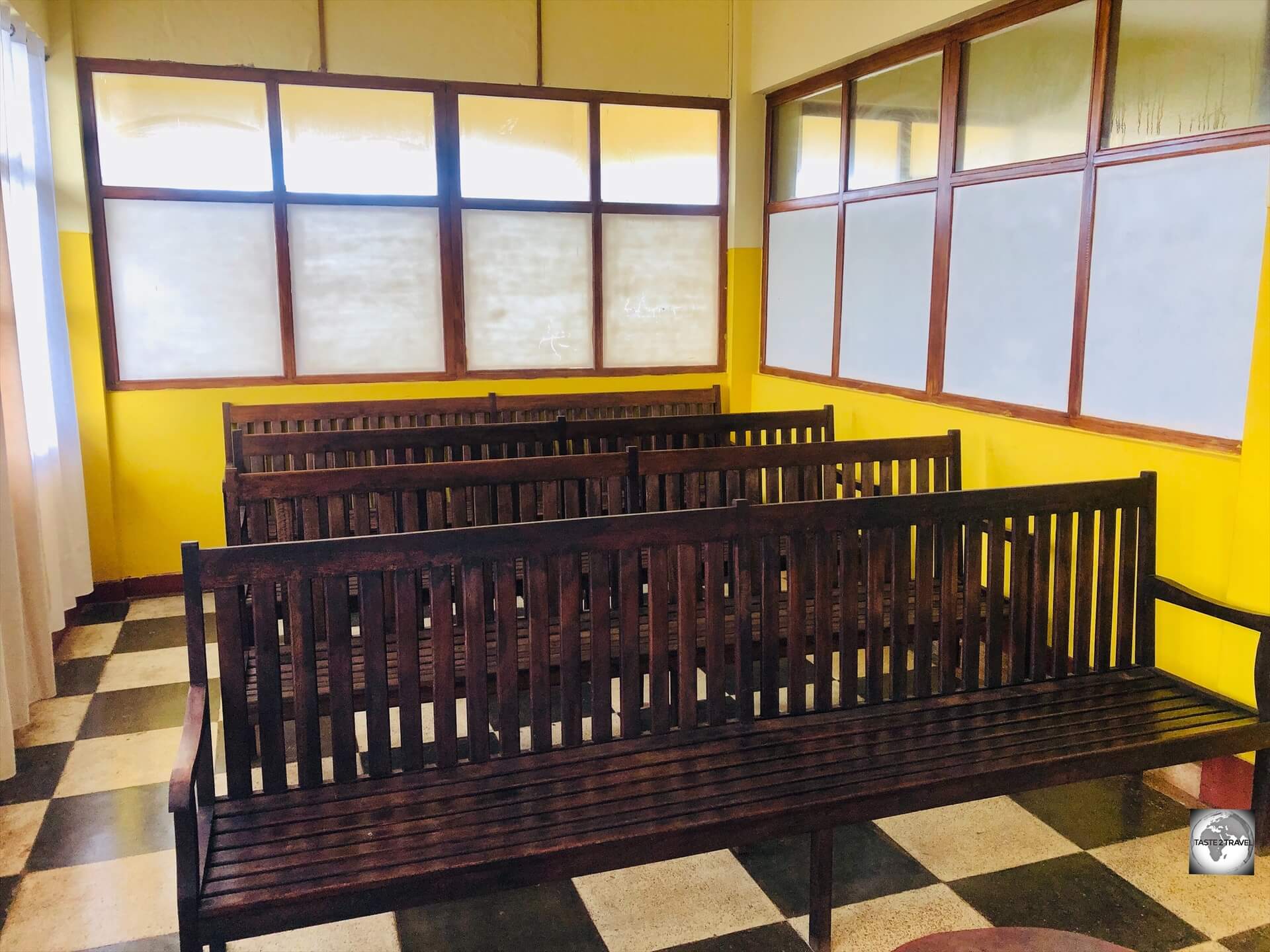
The empty waiting lounge at the very sleepy Principe airport.
The airline uses a chartered, 19-seater, BAe Jetstream 32, plane from SEVENAIR – a Portuguese charter airline.
On both of my flights, there were no more than half a dozen passengers on board.

Inter-islands flights between São Tomé Island and Príncipe are rarely busy.
Schedule
STP Airways provide flights between São Tomé and Principe islands as per the following schedule:
Monday – Wednesday – Thursday – Friday – Sunday
Flight Departure Arrival
8F211 TMS 09:00 PCP 09:40
8F212 PCP 10:20 TMS 11:00
8F213 TMS 15:00 PCP 15:40
8F214 PCP 16:20 TMS 17:00
Saturday
Flight Departure Arrival
8F211 TMS 08:00 PCP 08:40
8F212 PCP 09:10 TMS 09:50

My boarding pass for my inter-island flight from Principe to São Tomé.
Booking
Flights can be booked on the STP Airways website, with a round-trip costing about EUR €260.
Airport
Príncipe Airport lies 3 km north Santo Antonio, with two daily flights connecting Principe to São Tomé International Airport on STP Airways.
Public Transport
Public buses operate on São Tomé, with buses departing from the central market in downtown São Tomé.
Taxi
Shared and private taxis are available on São Tomé, with shared taxis departing from a rank outside central market in downtown São Tomé.
Rental Car

Exploring the lush, green rainforests of Principe in my rental car.
I chose to rent a car on both São Tomé and Principe.
On São Tomé, I paid EUR €40 per day, while on Principe, I paid EUR €50 per day.

Exploring São Tomé Island in my rental car.
In both cases, I had the option to add a guide/ driver at an additional EUR €50 per day.

All car license plates in São Tomé and Príncipe are prefixed with “STP”.
With a lack of road signs and rough, muddy, treacherous roads, I was very glad that I paid for a local driver on both islands.

My rental car, at Cascata de Sao Nicolau on São Tomé.
That’s the end of my São Tomé and Principe Travel Guide.
If you wish to leave any comments or contact me, you can do so using the form below or the via the Contact page.
Safe Travels!
Darren
Further Reading
Following is a list of my travel content from the region:
São Tomé and Principe Travel Guide São Tomé and Principe Travel Guide São Tomé and Principe Travel Guide São Tomé and Principe Travel Guide
São Tomé and Principe Travel Guide São Tomé and Principe Travel Guide São Tomé and Principe Travel Guide São Tomé and Principe Travel Guide
São Tomé and Principe Travel Guide São Tomé and Principe Travel Guide São Tomé and Principe Travel Guide São Tomé and Principe Travel Guide
São Tomé and Principe Travel Guide São Tomé and Principe Travel Guide São Tomé and Principe Travel Guide São Tomé and Principe Travel Guide
São Tomé and Principe Travel Guide São Tomé and Principe Travel Guide São Tomé and Principe Travel Guide São Tomé and Principe Travel Guide
São Tomé and Principe Travel Guide São Tomé and Principe Travel Guide São Tomé and Principe Travel Guide São Tomé and Principe Travel Guide
Author: Darren McLean
Darren McLean is an Australian, full-time, digital nomad who has spent 37 years on a slow meander around the globe, visiting all seven continents, 192/ 193 UN countries and 245/ 251 UN+ countries and territories.
He founded taste2travel to pique one’s curiosity and inspire wanderlust.







